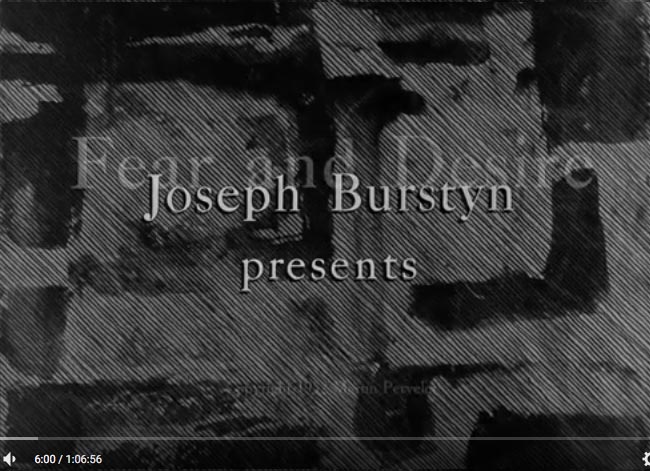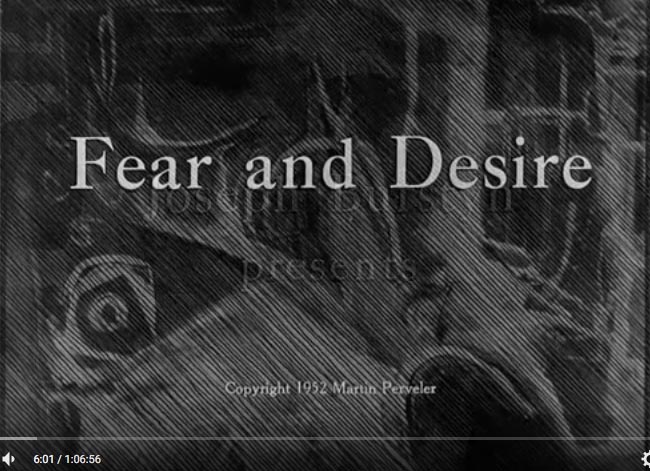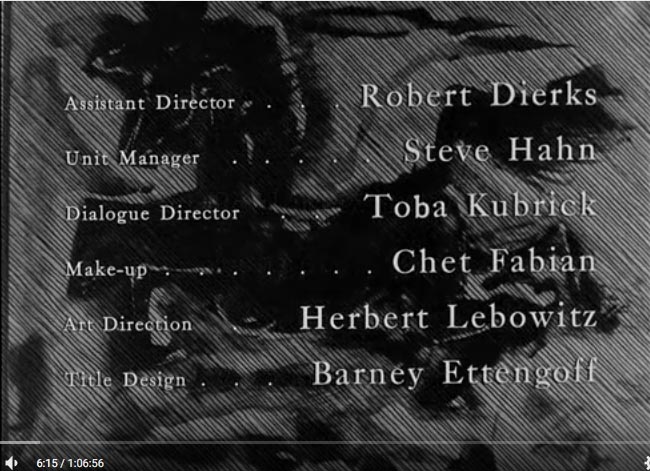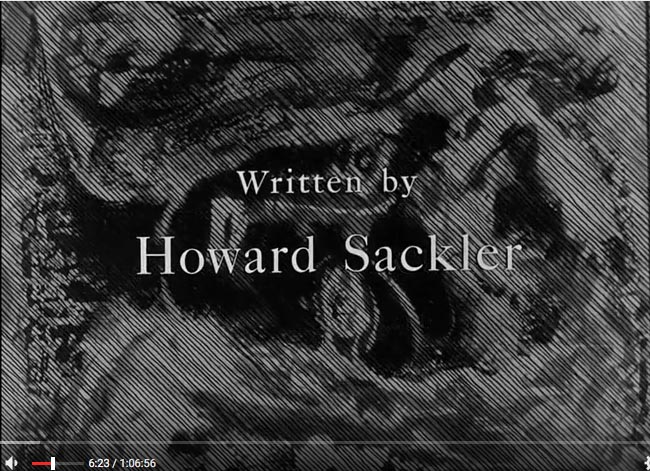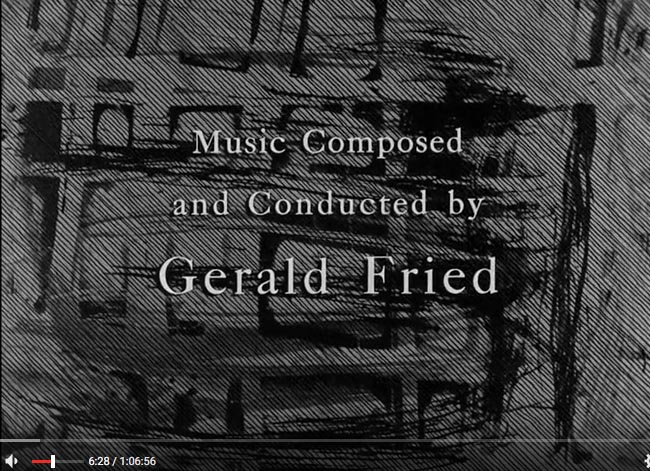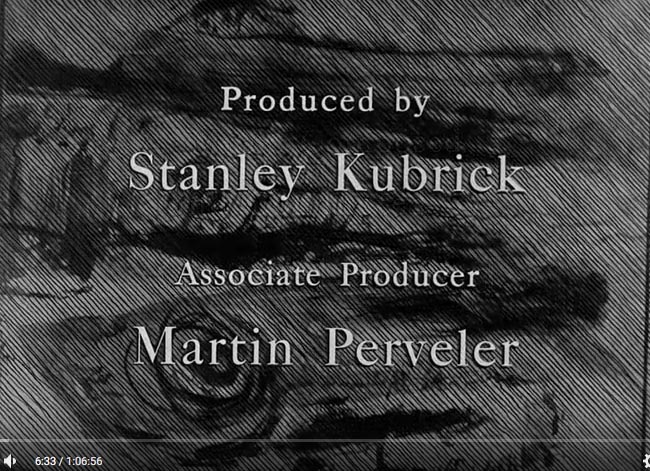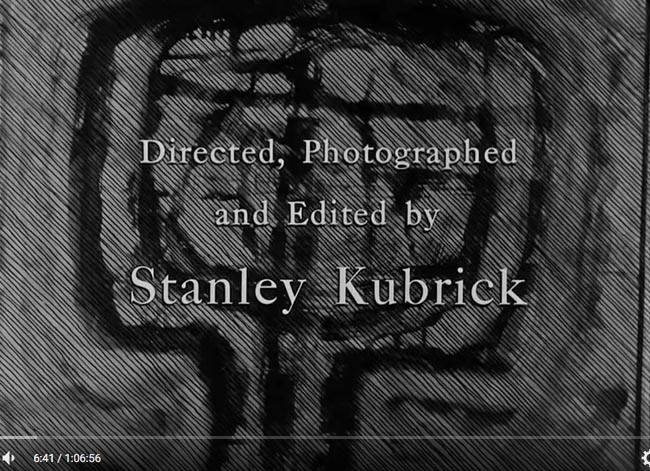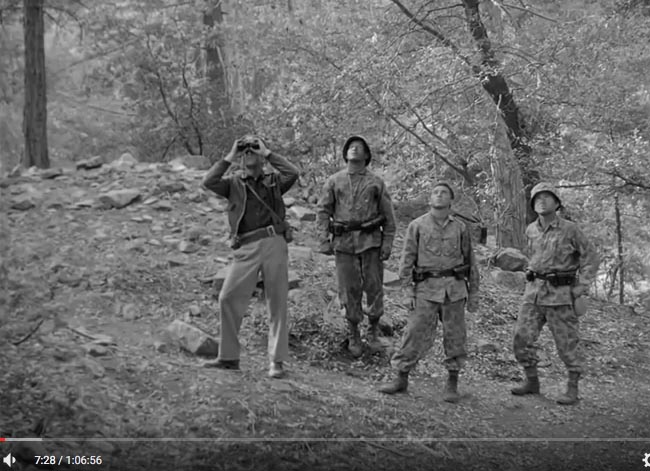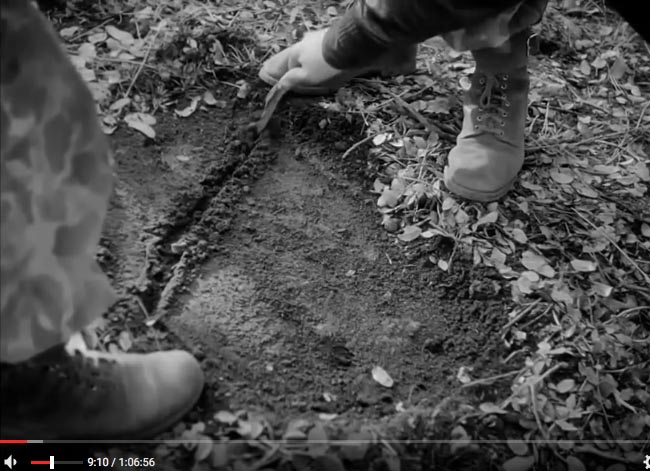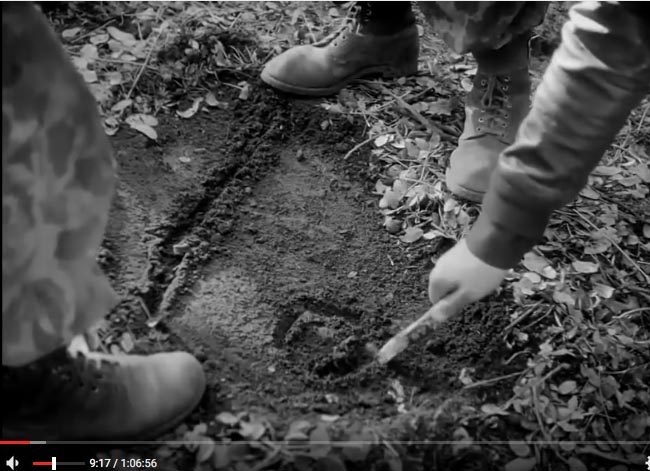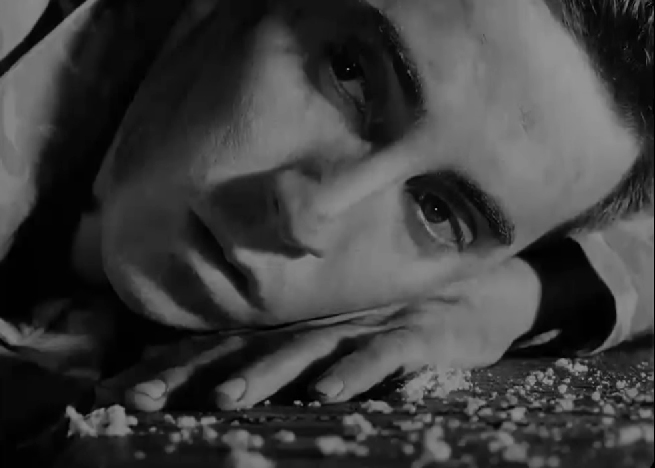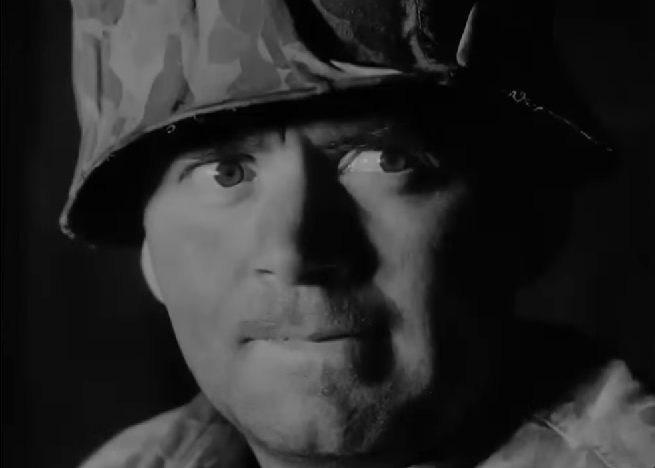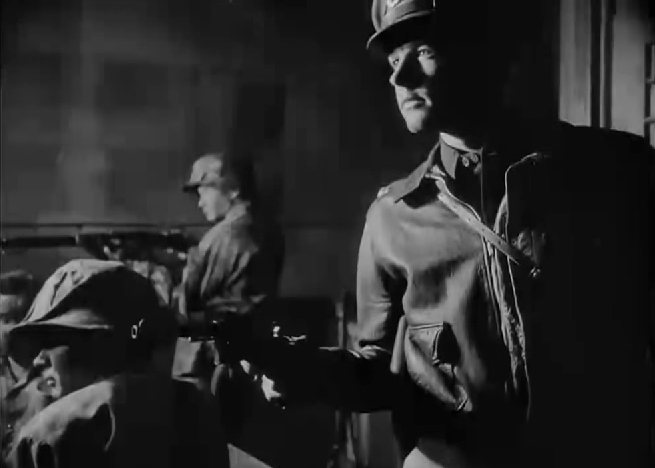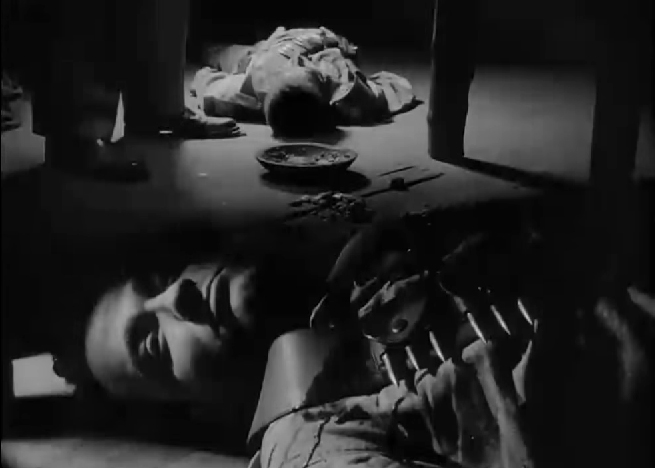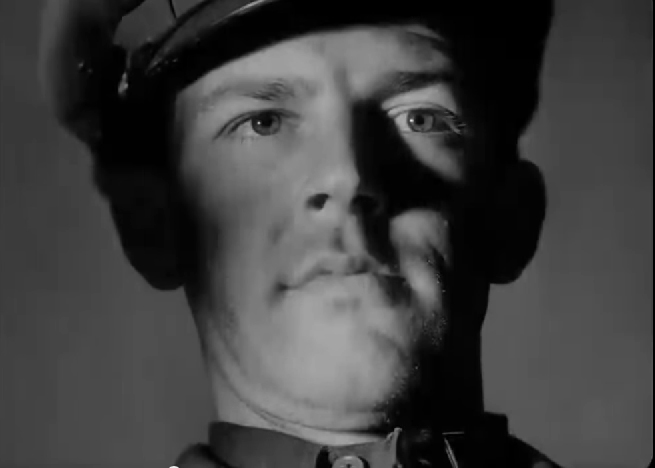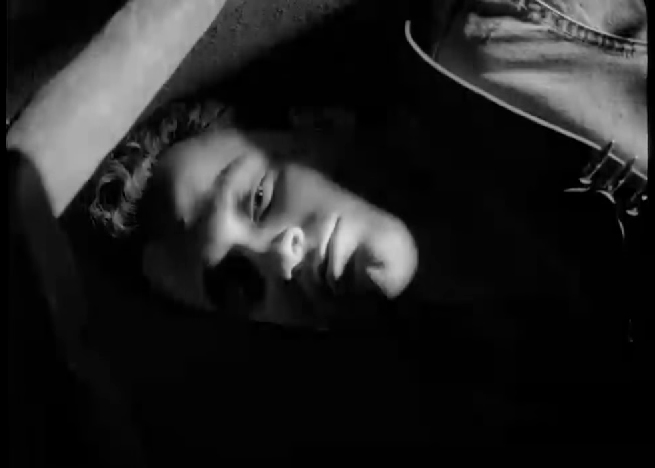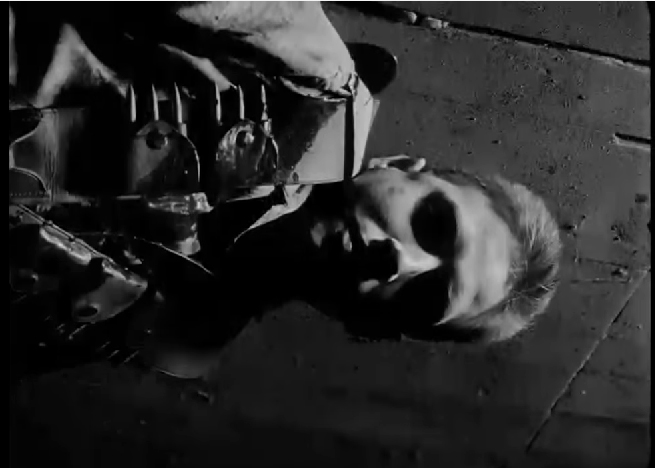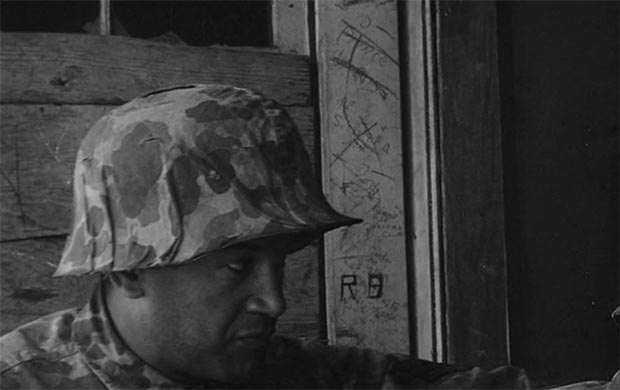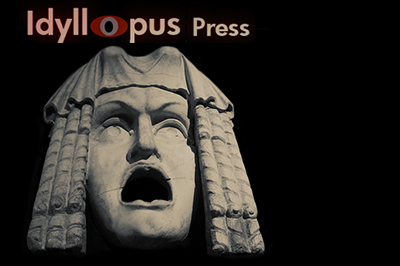STANLEY KUBRICK'S FEAR AND DESIRE

Go to TOC for this film ( (which has also a statement on purpose and manner of analysis and a disclaimer as to caveat emptor and my knowing anything authoritatively, which I do not, but I do try to not know earnestly, with some discretion, and considerable thought).
My old bones ache. Here's a maze trod indeed
Through forthrights and meanders. By your patience,
I needs must rest me.
Gonzalo, The Tempest, Act 3, Scene 3
Frank Silvera - Sgt. Mac
Kenneth Harp - Lt. Corby and the General
Paul Mazursky - Pvt. Sidney
Stephen Coit - Pvt. Fletcher and the Captain
Virginia Leith - Girl
David Allen - Narrator
Writer - Howard Sackler
Music - Gerald Fried
Release date - April 1 1953
IMDB gives the film as an hour and 2 minutes long, 62 minutes.
They were kids. Howard Sackler was about twenty-three, and Kubrick was about twenty-four, when working on Fear and Desire. And so was Gerald Fried. This was a first credit for Sackler who went on to do The Great White Hope. Fried had previously worked with Kubrick on his boxing short Day of the Fight. Kenneth Harper was born in '24, Silvera in '14, Mazursky in '30, Coit in '21, Leith in '32. Just wanted to give some ages straight out of the gate on this one because they were going for art, were young, and a lot of what was done is just right for young art, first-feature filmmaking. There was a lot to be learned. The desired reach too far extended the grasp in this film, but it was a noble effort for a young filmmaker and screenwriter, certainly. Big, deep meaning was wanted, not just a war story, not war genre, not fodder for the matinee mill. For someone who has bitten off a huge chunk of sandwich with a project of this type, it's actually pretty damn good for someone of about twenty-four years of age. The reach that extends the grasp reveals the just right amount of immaturity and lack of experience that hasn't anticipated the difficulties involved, but is promising in its ambition, its desire to be of thoughtful consequence, and its risk-taking that produces some outstanding if clumsy sequences.
In interviews, Mazursky would remark on how it was through Fear and Desire that he was drawn to the story of The Tempest as well and would himself later do a movie based on the play. Mazursky commented on the number of synchronicities involved in Fear and Desire and his association with it and was quite impressed by them decades after the fact, so his time spent working on Fear and Desire seems to have been a powerful experience.
DAY ONE
TOC and Supplemental Posts | Part 1 | Part 2 | Part 3 | Films Home
Links to sections of the analysis on this page:
Credits
Notes on the Credits: Examining relationships in the credits to The Tempest and its illusory storm, the symbolism and alchemy behind the horse-centaur in the credits and the Shakespearean minotaur as well as doublings (twins), and Prospero as both magician and director of a play
Behind Enemy Lines Shots 9 through 65
Notes on Behind the Lines: Prospero's magic circle. The characters and situation. The marooning tempest. Doubles. The mouse-trap map as one of Prospero's magic sigils. Proteus and other "animals". Idiosyncratic shots such as the CU of the hand throwing the stone and their rarity of appearance in Kubrick's later movies.
On the Way to the River Shots 66 through 98.
Notes for On the Way to the River: Ariel's noise that both guides and confounds and its influence on thought. No more forests after this in Kubrick's films. Character development.
Building the Raft and Seeing the Enemy Shots 99 through 151
Notes on Building the Raft and Seeing the Enemy: Camouflage and Huckleberry Finn. The skewing of the sense of direction. The maze and deja vu. The plane, the circle in the sky, and the mouse-trap.
The Killing Dinner shots 152 through 227
Notes on The Killing Dinner: Corby's control of Sidney. The flipped shots and diagonals. The benign knife and the murderous knife. The CU of the hand clutching the stew. The eyes of the living and the dead. The expresion of the dead as liminal, the relationship of the dead to the mannequins in Killer's Kiss and Eyes Wide Shut. The banquet in The Tempest. We have passed this way before. Sigils and the illusory death of Ferdinand. We spend our lives running our fingers down the lists and directories, looking for our real names. The rebuke of Donne's "no man is an island", and Corby's assertion that war as cold stew on a blazing island with a tempest of gunfire around it.
CREDITS
1 Title card Joseph Burstyn presents
This image hints at box shapes, much like those in shot 6, but as if they have been zoomed in on.
2 Fear and Desire
The image is abstract enough that I can't begin to parse it. Perhaps there is a face, perhaps not. After this shot the images become less abstract.
3 with Frank Silvera, Paul Mazursky, Kenneth Harp, Steve Coit, Virginia Leith
These credits are over horizontal art of a face. .
4 Assistant Director, Robert Dierks; Unit manager, Steve Hahn; Dialogue Director, Toba Kubrick; Make-up, Chet Fabian; Art Direction, Herbert Lebowitz; Title Design, Barney Ettengoff
The credits are over art of a running horse. Why a horse? This will be discussed below.
5 Written by Howard Sackler
We return to credits over horizontal art of a woman's face, the face less abstracted than in 3.
6 Music Composed and Conducted by Gerald Fried (over art of urban windows)
The seeming art of urban windows is odd, but not so odd as the running horse.
7 Produced by Stanley Kubrick; Associate Producer, Martin PervelerWe have here art of a hand coming out of a shirt cuff, seemingly positioned over a face.
8 Directed, Photographed and Edited by Stanley Kubrick.
The art, I'm making a wild guess, is maybe a target viewed through a gun sight. The Fade to black.
The artist, Barney Etengoff, is likely the same as did illustrations for a story in the June 1959 issue of High Adventure.

Image from barebonesez blogspot
CREDITS: THINGS TO NOTE
Examining relationships in the credits to The Tempest and its illusory storm, the symbolism and alchemy behind the horse-centaur in the credits and the Shakespearean minotaur as well as doublings (twins), and Prospero as both magician and director of a play
The art design for the credits is curious. With the exception of a couple of drawings, at first glance they seem to contribute little to the film and have no relationship with the film. The style seems more appropriate for Killer's Kiss, particuarly with when the photo negative effect is used, anticipating the use of this in Davey's dream in that film, and I rather feel that Kubrick was wishing he was shooting in New York whereas he was instead in a camp in the California mountains. We move from pure abstraction at the beginning to the figurative. The art in shot 1 is composed of box-like shapes. The chaos of shot 2 may, with some concerted discernment, resolve into a facial shape that suggests a scream, a wide eye on the left and an open wide mouth lower right, but this may be simple pareidolia and I'm not at all bound to that read. In shot 3 we have emergent the certainty of a person's face but whether it is male or female we can't tell, it is simply human, positioned horizontally. In shot 4 we break away to a horse depicted in such vigorous motion that it may appear to have two heads. After this, in shot 5, the face differentiates and is shown as a woman's, again horizontally aligned and possibly that of "the girl" who will be killed (who shall hereafter be called "the woman"). We return then again to the box-like forms vaguely introduced in shot 1, though now they have multiplied and look like windows on an urban high-rise. In shot 7 we see a hand emerging from a shirt-cuff. In the scene in which the two dining enemy soldiers are killed, we have a repeated emphasis on the hand grasping at stew spilling out of a bowl, but later in the film we also have several shots focusing on Lt. Corby's hand as he plays with a stick digging in the earth, the horizontal lines of this hand in the credit art recalling perhaps the horizontal strokes over the box shapes in shot 6. In shot 7, the last shot of the credits, we have the crosshairs of a gun-sight trained on a person. "The woman", a soldier, Mac, and the enemy general and captain are all killed with a gun in Fear and Desire. There are no urban buildings or horses in Fear and Desire, so one wonders at how they relate to the film. Does the art suggest that under the countryside of the enemy territory is instead the city, and that the story is not so much about war but urban life or life in general? The opening narration that follows would support this. We're tasked with trying to conceive a relationship between the credits to the film, as it seems unreasonable that Kubrick would opt, with his first feature, to introduce it with art that is absolutely dissociated from the plot.
Fear and Desire owes much to The Tempest. Having given some thought to the strong diagonals traversing each drawing, I'm inclined to wonder if the diagonals aren't suggestive of the great storm with which The Tempest opens, which Prospero conjures to intentionally drive the passengers of a ship to the island upon which he and his daughter have been shipwrecked. Those diagonals strike through the drawings as a harsh, driving rain.
And in The Tempest is where we may have to seek the reason for the horse, which is one of the most peculiar images in the credits. For nowhere in the film is a horse ever mentioned, but we do find a reference to a horse in the play. So it is with Kubrick that information that is left out of a film will still have an influence on it and contribute meaning.
First, I should perhaps give a bit of the story of The Tempest, which influenced Fear and Desire and is quoted in the film.
Prospero's sorcery raises a great storm (a tempest) that causes the seafarers on a passing ship to be marooned on his island. Amongst that group is his brother, Antonio, who stole his title as the Duke of Milan, and Alonso, the King of Naples, who recognized Antonio as the Duke. Consequently, Prospero and his daughter had been sent into exile, however their ship was wrecked and they have lived twelve years on this island, the raw environment tempered by Prospero's magic, an agent of which is Ariel, a spirit that had been imprisoned on the isle by a sorceress who had previously marooned on the island with her son, Caliban. Prospero wants revenge on Antonio and Alonso, but he also desires that his daughter, Miranda, and Ferdinand, Alonso's son, fall in love and marry, and that his title and estate be restored.
The individuals marooned with Alonso, Antonio, and Ferdinand include also Sebastian, Alonso's brother (who hopes to depose Alonso), a drunken butler to the King named Stephano, and the King's jester, Trinculo. There are others but these are of greatest importance.
In The Tempest we are certainly supposed to sympathize with Prospero over Antonio, to view Antonio as evil, and Prospero, the wronged, as good. But the language of the play--though Prospero is conceived of as practicing only the good and beautiful magical arts--from the beginning reveals a dark side to Prospero, and he has come to be viewed as analogous with colonialism, for Prospero enslaves both Ariel and Caliban, prior residents of the isle, treating Caliban with especial severity, and Caliban would have revenge on Prospero as he feels the island was rightfully his own as he was there first. Prospero is also harsh with Ferdinand, so much so that Miranda has to apologize for her father, beseeching Ferdinand to understand that he's not as ill-tempered as he appears to be. Indeed, Prospero's harsh treatment of Ferdinand and his fellows is part of a plan, for he is inclined toward Ferdinand and Miranda falling in love and marrying. Still, even though he has ulterior motives to their good, he imprisons and enslaves Ferdinand, and those behaviors are real to Ferdinand, not an act, not part of a play. And, again, Prospero has behaved as a tyrant with Caliban and torments him continually in order to keep him subdued in his enslavement.
The harshness of the revenge Prospero exacts on Alonso and his party is such that Ariel must entreat him to have pity and relieve them of their confusion and despair.
The Tempest is a play of illusions. The shipwreck was but an illusion. The passengers don't know this and believe the ship is wrecked. As they have been separated into several groups, each of those groups believes the others are dead. But they are not. No one has died. So if the driving rain of a tempest is throughout the title cards of Fear and Desire, then one must wonder at the title cards referring to the illusory storm and what this may mean as regards the story and what we believe we observe.
Now to that image of the horse in the credits. If we are to begin to understand it, we must look to The Tempest and Caliban.
Eric C. Brown, in "Shakespeare's Idea of the Centaur", writes:
The New World centaurs can be traced through the 1603 publication of Montaigne's Essays, translated by John Florio, in which an interesting chapter appears some one-hundred pages after the famous 'Of the Cannibals', generally regarded as a source for Shakespeare's construction of Caliban in The Tempest. The essay, 'Of Steeds, Called in French Destriers', is of course connected with horses, one of Shakespeare's favourite topics. Montaigne begins with an etymological discussion, but soon meanders his way into discussion of horses and riders glorious enough to challenge even the Duke of Bourbon in Henry V, who proclaims his mount is 'indeed a horse, and all other jades you may call beasts'. If Shakespeare was combing the Essays for accounts of the New World, he likely would have noticed Montaigne's account of the conquering Spanish horsemen...
That same literature offers a tale in which it was related that the indigenous of the "New World", unacquainted with horses, at first confused a horse and its rider as being a single creature. Whether or not this was true is not the concern here, we are dealing with people who believed the tale to be true. Brown continues:
The report bears some semblance to The Tempest, when Stefano drunkenly believes Caliban and Trinculo to be one supernatural quadruped, of which he remarks ' Have we devils here? Do you put tricks upon's with savages and men of Ind, ha?...Four legs and two voices--a most delicate monster!' Both the conflation of horses and men in the conquest of the Indies, and the hybridization of Caliban and Trinculo in The Tempest, embody the idea of the mythological centaur.
...the connection is made between ancient myth and modern perception; the 'monster Centaurus' is realized in the cultural novelty of the horse and rider juxtaposed. Shakespeare may well have drawn on this account for his caricature of the hybrid Caliban and Trinculo in The Tempest, but the account may also have spurred on the dramatizing of beast and man in Othello...
So, in The Tempest we have a Centaur, a hybrid of horse and rider.
The passage referred to in the above concerns Caliban being discovered by Trinculo and Stephano. Caliban is out gathering wood for the tyrannical Prospero who has threatened him with magic-induced physical pain if he doesn't comply. While gathering the wood, cursing Prospero who has caused him so much suffering, Caliban sees Trinculo. Believing him to be a spirit and fearing him, Caliban throws himself on the ground and covers himself with his "gaberdine" (a cloak) in the hope he'll not be noticed. Another storm is brewing and Trinculo meditates on this as he wanders, how there is no place to hide himself--which tells us something of the nature of much of the island, The Tempest having been performed on a bare stage. Coming upon Caliban, Trinculo gazes on him at first in confusion. Caliban's exact appearance is never stated, though Prospero at first describes him as having a human shape, and Trinculo at first believes him to be deformed, having arms like fins. Trinculo wonders if the thing is a fish or a man, dead or alive. Deciding the thing is an islander, as the storm thunderously attacks, Trinculo takes refuge under Caliban's "gaberdine" with him. They are both lying there together when a drunken Stephano enters, notices the creature lying on the ground, and is confounded. Caliban, fearful of Trinculo, begs him for mercy, pleading not to be hurt. Hearing only Caliban's voice at first, Stephano thinks the creature beneath the cloak is one with four legs and one voice. Then he hears Trinculo and realizes it has two voices, one speaking "well" and the other a detracting fool's voice. Finally, Stephano and Trinculo, who had been separated in the storm that set them on the island, recognize one another's voices and are reunited.
Caliban-Trinculo has been at first thought to have four legs and one voice, which is understood to be a creature at least akin to a centaur, a man and horse melded together. Then Caliban-Trinculo becomes a creature of four legs and two voices, one dividing into two. With Kubrick that leads us also into the realm of doubles. Lt. Corby, in Fear and Desire becomes also the enemy General, and Pvt. Fletcher is revealed to be also the enemy Captain, two actors playing two characters. The General and the Captain will be killed by their doubles.
There are many illusions in The Tempest, and other hybrids. Ariel seems as a harpy at one point and with its wings sweeps away a feast on a table so that Alonso and his men may not dine, which will be alluded to in a dinner scene in this film.
Caliban is also described by Trinculo and Stephano as being a moon-calf. What did Shakespeare mean by that? A moon-calf may be either a simpleton or a creature deformed by the moon when in the womb.
If Kubrick opens Fear and Desire with a horse in the credits depicting the centaur Caliban-Trinculo in The Tempest, he opens Killer's Kiss with another fantastic hybrid, Minotaur Productions. Shakespeare links the moon-calf with the minotaur. In A Midsummer Night's Dream, Theseus, slayer of the Minotaur, remarks at the very beginning on how it is four days until another moon and that he must wait until then before he can be married. Why? Because the time between the waning of the moon and the birth of the next was that of the dark moon. Martin White, in his commentary on A Midsummer Night's Dream, states,
...it was a time associated with a woman's menstrual period, during which sexual activity was associated with the likelihood of producing a malformed baby--what the Elizabethans termed a 'moon-calf'--an outcome that Theseus, slayer of the Minotaur, a bull-headed man--might be especially anxious to avoid.
It's a short leap from there to see how Caliban can be viewed as not just a centaur but, as a moon-calf, a minotaur.
There's no shortage of commentary on Shakespeare's use of the centaur/horse-and-rider word play. In King Lear it is women who are given as belonging to god down to the girdle, but below they are devilish centaurs with "riotous appetite". Commentary often also associates the centaur with twinship, such as in the case of The Comedy of Errors.
Garton, Charles. "Centaurs, the Sea and The Comedy of Errors. Arethusa, 12 (1979), 233-54. "Suggests that the name Antipholus in Err. is compounded of anti- and Pholus, the name of a centaur Shakespeare would have encountered in Ovid. It means both 'counterpart to a centaur' and 'reciprocal to a centaur,' descriptions appropriate to each of the twins in his relationship to the other. Acting as a mythopoeic shorthand, 'Antipholus' encodes the centaur-like ambiguity of identity that bedevils the twins, as well as their animal-live vitality. The name of the inn--the Centaur--where Antipholus of Syracuse lodges also reinforces the connection. In mythology, centaurs were associated with the sea through their protector Poseidon, and thus the setting of the play in a seascape is appropriate, as is the naming of the twins' father after Aegeus, the son of Neptune."
Source: Shakespeare and the Classical Tradition: An Annotated Bibliography, 1961-1991
Who is Aegeus, the father of these centaur-like twins, but the father of Theseus, he who conquers the labyrinth, with the help of Ariadne's thread, and slays the Minotaur. In one myth, before his conquest of the Minotaur, Theseus must capture the Marathonian Bull which is the very father of the Minotaur. After its capture and sacrifice he continued on to Crete where he killed the Minotaur.
Caliban as a moon-calf in The Tempest, and the reason for Theseus' inability to marry until the new moon in A Midsummer Night's Dream, remark one upon the other. An allusion to sexual union is something not to be found in commentaries I've looked at, but when one is watching the play rather than reading it, as Trinculo creeps under the cloak with Caliban, and the manner in which Caliban protests, sex may come to mind, especially when the creature with four legs and one voice changes into a creature with four legs and two voices--and I can imagine this the source of some laughter in the audience, which befits Trinculo's occupation as a jester. Though intercourse is baudily suggested, Stephano's subseqent deliverance of Trinculo is specifically related to defecation but also brings to mind a birth.
STEPHANO
If thou beest Trinculo, come forth. I'll pull thee by the lesser legs. If any be Trinculo's legs, these are they. (pulls TRINCULO out from under the gaberdine) Thou art very Trinculo indeed! How camest thou to be the siege of this mooncalf? Can he vent Trinculos?
The "siege" means excrement, but the evacuation of Trinculo is also birth-like.
To speak of excrement in the play is not only to be ribald and rude and make jest, it is also the language of an alchemical process. By way of this, we might want to briefly touch upon alchemy and Shakespeare, and how both Prospero and the playwright are alchemists.
In creating The Tempest's magical elements, Shakespeare might also have been influenced by the street wizard, a figure from legend and contemporary society. Street magicians, jugglers and conjurers were a frequent feature of Jacobean urban life and were often depicted on London stages. Shakespeare's audience would have recognized the ubiquitous type in Prospero...As a combination of serious magician and carnival illusionist, Prospero manipulates with characteristic legerdemain what the audiences--and the characters on the island--observe (Mowat, 'Hocus'). In that, of course, he is akin to the playwright.
The Tempest itself can be compared to one form of magic, the alchemical process. The title is the alchemical term for the boiling of the alembic to remove impurities and transform the base metal into purest gold (Mebane, 181); if we see Prospero's goal as the transformation of fallen human nature--Caliban, Antonio, Sebastian and Alonso--from a condition of sinfulness to a higher level of morality, the play's episodes mirror the alchemical process. Note particularly Prospero's alchemical language at the beginning of Act 5 ('My charms crack not') to describe his project; by 'boiling' his enemies' brains (5.1.60), he attempts to transform their characters...
Prospero bears the physical signifiers a Jacobean audience would have associated with power: books, staff and robe...In his first appearance he plucks off his magic garment and assures Miranda that the tempest she has witnessed is really an illusion...
Source: The Tempest, Alden T. Vaughan
First and foremost, Prospero is not only a magician and deposed ruler, he is also the author if this "play" that he presents on his island, one that is mistaken as being real life, yet is also real life for the illusions have real consequences. He is the director, and so we find in Kubrick's first full production the director as magician. He ended Eyes Wide Shut with an allusion to the director as magician with the game of The Magic Circle. Indeed, the director as magician is suggested in all his works.
Continuing...
Two of alchemy's principal refining processes were distillation, or the evaporation and recondensation of liquids, and sublimation, or the evaporation and recondensation of solids. Both aimed at separating and elevating a purer and more spiritualized substance from a grosser and more corporeal one.
...Alchemical sublimation...produces two substances: a purified and spiritualized essence and, separated from this, a fecal discharge or remainder. In turning solid to gas, and gas back to solid, sublimation was seen as transforming body to spirit and spirit to body. The goal was not a separation of spirit from matter but a reconciliation of spirit with a purified matter: hence the sublimate was often compared to an infant emerging from the womb or to Christ's resurrected body. The fecal remainder, by contrast, was associated variously with earth, with menses, with putrefaction, and with death. Flamel writes of this discharge or remainder that 'it stinks, and gives a smell like the odour of graves filled with rottennesse, and with bodies as yet charged with their naturall moysture." It is also, not incidentally, associated with the female body. ..sublimation is thus not only a purifying but a defeminizing process, qualities that will persist when the concept is adopted by Freud...
Source: Shakespeare's Perfume: Sodomy and Sublimity in the Sonnets, Wilde, Freud, and Lacan, by Richard Halpern
One can apply this to Trinculo's situation with Caliban. Caliban mistakes Trinculo for a spirit. Trinculo hides under Caliban's coat as another tempest rages (we may even view Caliban's cloak as a counterpart of the robe Prospero wears when brewing tempests and other magic) then what is corporeal is separated. Though he is "borne" he is described as excremental.
Trinculo is then disdained by Caliban, Stephano however getting Caliban's favor as he introduces Caliban to the alchemy of Dionysian wine, which Caliban has never tasted before. Stephano jokingly identifies himself as the man in the moon, and due the wonderful effect of the wine, and Stephano's identification with the moon, Caliban promises to worship and serve him. He sees him as his savior.
I have seen thee in her (the moon) and I do adore thee. My mistress showed me thee and thy dog and thy bush.
"My mistress" was Caliban's mother, the powerful "witch" who died before Prospero came to the island.
The imagery of the moon with its dog and bush belongs to folklore of the time. A man with a bush, or carrying sticks, had been banished to the moon to the end of time, and sometimes was envisioned as having a dog as his companion. Shakespeare also made use of the man-in-the-moon folklore in A Midsummer Night's Dream, and his being sometimes pictured as carrying also a lantern. "He comes in to disfigure, or to present, the person of Moonshine."
From then on, Caliban's motivation in the play is to have Stephano kill Prospero and gain control of the island.
What significance The Tempest's centaur has to Fear and Desire, an association forged with the image of the horse in the credits, the head of which seems to be caught in movement so that it seems to be depicted twice, has much to do with the doubling of characters, their twinning, such as found with Corby and the General, this theme of twinning and doubling being one that will be repeated through all of Kubrick's films. But it doesn't hurt to examine multiple possible aspects of the Caliban/Trinculo episode, as I've done above, for there are layers of meaning to be had. And because The Tempest did influence Fear and Desire means it merits more than a cursory examination if we are to catch some of these more subtle references.
I was hoping to tease out the meaning behind the image of the horse in the credits, and reasoned that as there are no horses in Fear and Desire, we might find the horse in The Tempest, Fear and Desire having been greatly influenced by Shakespeare's play. So, we have.There is much in Fear and Desire that is rooted in The Tempest but not immediately recognizable as such.
What about the many squares that call to mind windows in an urban high rise? If they are windows of a high rise, one could look at the play as not so much an anti-war film but a story that has to do with power and conflict in everyday life. But it may be also that those squares could be viewed as shots on a film strip.
BEHIND ENEMY LINES
9 Fade-in to forest mountainside. During VO the camera pans left over the hillside to the valley.
VO: There is war in this forest. Not a war that has been fought,
or one that will be, but any war. And the enemies who struggle here do not exist unless we call them into being. This forest, then, and all that happens now, is outside history. Only the unchanging shapes of fear and doubt and death are from our world.
10 MLS 4 soldiers in the forest looking up at the sky, the lieutenant with binoculars. They hold their postures in such a way they should communicate being frozen in time, as if in a snapshot. Corby, Mac, Sidney, Fletcher.
VO: These soldiers that you see keep our language and our time, but have no other country than the mind.
Before we see it, the sound of an airplane enters.
11 Airplane in sky.
12 MS from left side of the soldiers watching the plane. Corby, Sidney, Mac, Fletcher.
SIDNEY: Do you think they're looking for us?
CORBY: It's one of ours alright.
SIDNEY: He can't see us. But maybe they saw our plane back there.
13 Airplane in the sky.
14 MCU from front of Mac, Fletcher and Sidney.
FLETCHER: There isn't much left of it to see, unless it's still burning.
15 MS Mac, Fletcher, Sidney, Corby from the left.
MAC: Even if they could spot us, there isn't anything they could do to help us here.
SIDNEY: Yeah. Six miles behind the enemy lines.
MAC: Well, that's not too...
16 MCU from right of soldiers, Corby in foreground.
CORBY: ...far.
MAC: Not too far? In those six miles there's probably
thousand of guys, and every one of them was taught to shoot at uniforms like this.
CORBY: If you're so worried about that why don't you keep your voice down?
MAC: I'm not worried.
17 CU Sidney.
SIDNEY: What's going to happen, Lieutenant? If somebody around saw our plane go down, they might be looking for us in the woods already.
18 MCU Corby.
CORBY: I'd feel a lot easier if our arsenal was better stocked.
19 CU Corby's hand pats his pistol.
CORBY: It isn't very much.
20 MS Fletcher, Sidney and Corby.
CORBY: Too bad you fellows didn't get your rifles out of the plane.
21 CU Sidney.
22 Very brief cut to Corby and Fletcher.
23 To Sidney and Corby from the left. Corby kneels down as he speaks and clears leaves from the earth.
CORBY: Let's see what can be done. Once you understand how a mousetrap works, if you're clever enough you can use it as a springboard.
24 MS Mac and Fletcher. Sounds of booming gunfire in the distance.
25 MS of Corby's hand, with a twig, drawing a diagonal line at the top of the oval of the cleared space.
CORBY: Here are the front lines.
26 MS Corby with Mac beside.
CORBY: From our position just before we crashed...
27 MS of Corby's twig drawing a circle (more like a reverse C) below the diagonal, at the bottom of the oval area.
CORBY: ...we should be in this general area.(He reinforces the diagonal.) Our own lines are here
and we should be about here. (He stabs the stick in the area of the reverse C.) There's a river that runs east of where we are now, I think. (Stick still in the ground, he pulls a line out of the C area, to the right, and up through the diagonal.) And that river cuts through the front lines (he reinforces the diagonal) and winds up on our side. (He stabs the stick on the river line below the diagonal/horizontal.) Now...
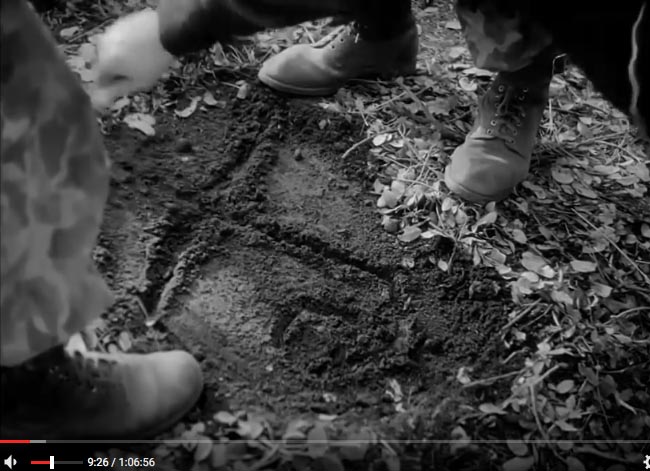
28 CU of Mac.
CORBY: Now, as I see it, we might be able to use our reconditioned mouse trap on the river.
MAC: Is that your idea? To go down the river?
CORBY: Yes.
SIDNEY: But how? How can we get down it?
29 MS Sidney.
SIDNEY: I can't swim very well.
And Fletcher...
30 MCU Corby and Mac standing beside him.
31 CU of Fletcher.
CORBY: We could...
32 MCU Corby and Mac beside him.
CORBY: ...do it on a raft.
At night.
33 MS Mac and Fletcher.
CORBY: Well, we'll never make it...
34 CU Sidney.
CORBY: ...any other way.
35 MS Mac and Fletcher as Corby stands.
CORBY:
It's suicide to try to walk out.
I wouldn't have the vaguest idea...
36 MS from the right of the four.
CORBY: ...of how and where to start.
This way we could just cruise through together in a few hours and arrive in one piece. Now, by my computations...
37 CU Mac.
MAC: Your computations.
38 CU Corby.
39 CU Mac.
MAC: It was your brilliant figuring
that got us here...
40 CU Corby.
MAC: ...in the first place.
41 CU Mac.
42 LS All four. Sound of leaves rustling behind them.
43 MLS from left of all four quickly turning. Sidney seems to be wearing a holster and reaches into it...
44 CU Corby reaching for his pistol.
45 MS Corby shoves Sidney away from in front of him...
46 MS ...he falling to the ground as Fletcher pulls out a knife.
47 MS of a dog.
48 MS the 3 men standing and Sidney on the ground.
49 The dog advances.
50 MLS from the side of the dog standing before them, Sidney still on the ground. Corby reholsters his pistol. The dog advances to Sidney who pets it.
51 CU Fletcher smiles.
52 MS Sidney and the dog.
CORBY: Hmmm, it must be somebody's pet. It has a collar.
MAC: Nah, make a better watch dog.
FLETCHER (southern accent, first time he's spoken):
Seems friendly enough.
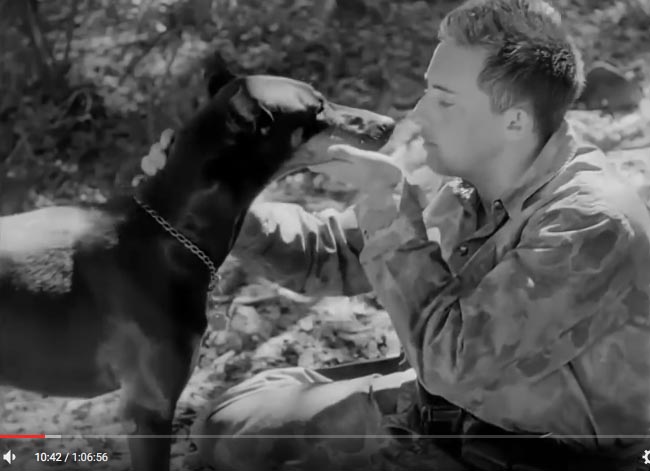
53 MS Corby and Mac.
54 MCU Sidney and the dog.
55 Corby and Mac. Now Corby fully reholsters his pistol?
CORBY: Well, we can't use a mascot
on this trip.
56 Corby picking up a rock.
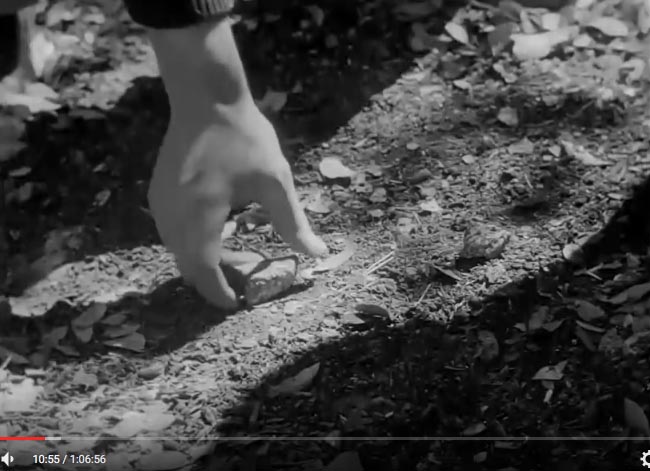
57 Corby and Mac.
58 Sidney and the dog. Sidney pats the dog, as if to send it along. The dog begins to trot away.
CORBY: Well, hurry up. We don't have all day.
59 MCU Corby throwing the rock.
60 The dog pursues the rock down a path. Shot from behind.
61 MCU Corby and Mac.
62 CU Sidney.
63 LS The four from behind looking down the trail. Sidney stands.
64 MS The four, Sidney and Fletcher with backs to the camera.
CORBY: If no one has a better suggestion, let's head for the river.
65 LS from behind as the four turn to the camera. Corby pulls his gun back out.
CORBY: Some more animals might show up.
The camera pans following them up the hill right, they going in the opposite direction of the path down which the dog had disappeared.
BEHIND ENEMY LINES: THINGS TO NOTE
With the intro, Kubrick announces, "If you're expecting normal Saturday matinee fare, this is not that." For a later audience already versed in The Twilight Zone, this is what we hear in the film's opening declaration and self-description, its caveat emptor, Rod Serling beckoning everyone in their living rooms to venture into realms beyond. But The Twilight Zone hadn't happened yet. Shakespeare had.
Prospero's magic circle
We move from a frozen photograph-type still of the men to action. Pure theatrics. But Kubrick's art wasn't suited for the theater which loves its actors and words and may rely very little on the seen of the scene for communicating story.
This shot of the men seemingly, briefly frozen reminds of Act 5 Scene 1 in The Tempest, toward the end of the play, when Prospero traces a circle on the ground and by magic guides into it Alonso, Gonzalo, Sebastian, Antonio, Adrian and Francisco, who have been beset with madness in the illusory world conjured for them by Prospero, confined in it as "prisoners". The spirit, Ariel, has begged Prospero to have pity on these men, tormented to the brink of insanity with Prospero's illusions. Thus he calls them into the circle and freezes them within it. ("There stand, For you are spell-stopped.") He addresses each and forgives them as "their rising senses begin to chase the ignorant fumes that mantle their clearer reason."
Though we are at the beginning of Kubrick's film and only now is the journey commencing for these men, we have just finished viewing the landscape in which this story is set, and at the end of the film Kubrick finishes with returning to that same shot of the landscape. In this way too may we be reminded of Prospero's circle and the men frozen within it, beginning to emerge from their distracted state but not sensible to what is illusory or real.
The characters and situation
The opening sets up the plot and characters so we know what's going on and to whom it's happening. Four soldiers. Their plane has gone down six miles behind enemy lines. Corby, the Lieutenant, fulfills the need for the good-looking lead. He's something of a pompous jerk. Non-com Mac is gruff and no-nonsense, has seen his fair share of action and, as we will later learn, is not looking forward to a civilian afterlife. Fletcher is southern, the quiet and more easy-going one of the four who embodies the identity of the soldier-civilian who approaches military time as a job to be done and left behind when one returns home. Sidney is the anxious and innocent youth. All the distinguishing particulars may not be had yet, the few that are ever given, but the men are already types, and to some degree even individuals.
We are immediately made aware of conflict between Corby and Mac. The commissioned officer and the non-com. The war between the commissioned officer and the non-com is always present and to the fore in Kubrick's war films.
Kubrick loathes back story and gives none other than there was a plane that they were in and that it went down and it was the officer who got them in this mess.
The marooning tempest
This is how The Tempest begins, with Prospero's sorcery raising the storm that maroons his enemies on the island upon which he and his daughter had been shipwrecked in their exile.
Shakespeare's plot (which I've outlined briefly in the Credits section above) is replaced with these soldiers wrecked in enemy territory.
Doubles
Just as we have a confusion of identities, of hybrids, in the Shakespeare, as well as the confusion of two brothers who each claim to be the Duke of Milan, we'll have doublings and a confusion of identities in the Kubrick. The lieutenant will play also the part of the enemy general, the general seeming to also bear some correspondance with Prospero. Fletcher will play the general's captain.
As we shall see, Mac becomes as Caliban, his conflict with Lt. Corby being Caliban's conflict with Prospero. Yet the General is also as Prospero, and Mac will not be satisfied until he is able to convince Corby to kill the general before they escape. In The Tempest, Caliban instead promises to worship and serve Stephano, who has told Caliban he is the Man in the Moon, and persuades Stephano to kill Prospero.
The mouse-trap map as one of Prospero's magic sigils
Fear and Desire was originally called The Trap, which fits in with the sketch on the ground of what's described as a mousetrap. With a mousetrap you set the bait, the mouse goes for the bait, springs the trap, and is caught. To use it as a springboard seems to be Corby suggesting that the spring mechanism that traps the mouse is the same by which they will gain their freedom. This way of describing what becomes a plan to take a raft down the river seems far too elaborate. It is a forced attempt for a young Kubrick to communicate other ideas that are at play. I believe
it's likely the mouse-trap has to do with Hamlet. The mouse-trap in Hamlet is the play within a play by which Hamlet alerts his enemies he knows what they've done by having it acted out for them. If I bring this up it's because Kubrick often has a play within a play that serves somewhat the same function as Hamlet's mouse-trap, or as with the opera Pagliacci in which stage life slips over into real life. Kubrick often uses this device of the play within the play. Kubrick refers to this in The Killing. In Barry Lyndon the "play" is when his stepson, Lord Bullingdon, parades Barry's son wearing his own shoes, which expresses to all Bullingdon's grievances with Barry in such a way that they can no longer be ignored, and Barry is rejected. In Fear and Desire we will have it with Sidney relating a part of the story of The Tempest, first in paraphrase with a captive girl, and then quoting directly at the end of the film.
The why of Corby's sketching of the trap is, I think, is also going to connect with Prospero and his use of magic, Caliban speaking about how Prospero derives power from his magical books. The map that Corby draws also aligns him with the general, for later we will see the general surrounded by his own maps. One way to look at Corby's sketch in the earth is to view it as a magical sigil.

It's not difficult to find in what Corby has drawn the cross-hairs of the gun-sight in shot 8 of the credits. Or then the head on which the cross-hairs will be aimed. Or perhaps a version of the Chi-Ro, or even the Omega (the open C) cross. Omega is a symbol used by Kubrick in later work, most notably in The Killing, and he pairs it with the shooting of a horse. (See shots 272 through 280 in The Killing analysis, and the material on the Omega and the good luck horse shoe in the notes for those shots.)
Proteus and other "animals"
We learn later that the dog belongs to the enemy general and is named Proteus. The dog, like the mousetrap, like everything, is duplicitous and protean in that it is never exactly what it seems, but Kubrick is murky in this film and the poetry ends up bogging itself down. He was what, twenty-four when he made Fear and Desire. I imagine he thought he was being fairly straightforward with certain meanings, while at the same time keeping them cloaked, but he was being straightforward and cloaked in pretty much the way one might expect of a person twenty-four years of age.
Practicalities. Who the hell throws an object for a dog and doesn't expect it to play fetch and bring it back? The film, however, hinges upon the idea of metamorphosis, and it's to be considered that the throwing of the stone for the dog is answered in the scene of the killing of the woman they later take captive. A white form similar to the stone appears in her hand after she is shot.
Idiosyncratic shots such as the CU of the hand throwing the stone and their rarity of appearance in Kubrick's later films
Filming style. Very Kubrickian touches in this film are also things he would not use later on. For instance, the tendency to focus tightly on a detail. Kubrick later usually left the details to be viewed as part of the fuller mise en scene. It's very young Kubrick here to do the CU shot of Corby's hand picking up the stone to throw for the dog. And there are a number of other idiosyncratic shots that stand out against the ordinary. He's focusing on these things for a reason, but later he wouldn't do it. He'd leave the information as part of the greater whole. Later, there were never any, "See here, I want you to realize this is important so I'll give you a close-up of it" shots.
ON THE WAY TO THE RIVER
Music begins.
66 Crossfade to the group going right to left then up a hill to the camera.
67 Crossfade to them going left to right.
Voices begin narrating over, as if the voices in their heads, but sometimes it seems the voices don't match those of the soldiers.

UNCERTAIN VOICE:
It's hard. One foot fights the other.
VOICE: Faster.
POSSIBLY FLETCHER'S VOICE: (Unintelligible).
POSSIBLY CORBY'S VOICE: Get there, before it burns in
the bushes!
PERHAPS MAC'S VOICE: I could do it alone.
SIDNEY: It's a quarter to turn...
MAC'S VOICE: What am I doing with this bunch of cripples?
FLETCHER'S VOICE: Nobody's safe here.
UNCERTAIN VOICE: Are they watching me?
MAC'S VOICE: ...blame who. I'll blame the...
UNCERTAIN VOICE: (Unintelligible).
68 Crossfade to them advancing up the hill, right to left, toward the camera.
VOICE: I should look around.
VOICE: Getting hungry.
SIDNEY's VOICE: What's up?
MAC'S VOICE: They're all scared.
CORBY'S VOICE: How much is in back of us?
FLETCHER'S VOICE: So hungry (or so angry).
VOICE: ...time for night soon.
SIDNEY's VOICE (he keeps looking up in the air): ...look up later.
FLETCHER'S VOICE: All the twigs cracking in my head.
CORBY'S VOICE: Need to pause for the night.
MAC'S VOICE: Crash through myself.
69 Crossfade to a LS of them advancing toward the camera.
SIDNEY'S VOICE: The bird was wounded.
MAC'S VOICE: I don't run for no reason.
VOICE: ...the sun.
VOICE: Wait!
SIDNEY's VOICE: What's going to hang from the trees tonight?
CORBY'S VOICE: Hurry with them!
VOICE: I'm dying in the woods!
FLETCHER'S VOICE: (Unintelligible).
MAC'S VOICE: Maybe I'm getting old.
CORBY'S VOICE: Faster.
SIDNEY'S VOICE: Don't turn out the lights, please!
70 Crossfade to them crossing left to right uphill toward the camera.
VOICE: ...in the woods.
SIDNEY'S VOICE: Don't die here!
MAC'S VOICE: Who's scared?
VOICE: Dark.
VOICE: We'll be dead.
SIDNEY'S VOICE: (unintelligible) to the moon...please.
71 Crossfade to MS of them climbing under a fallen tree.
72 Crossfade to MLS of them walking on more level land towards the camera. The voices are gone and the music fades out.
73 Forest. They appear in the medium distance and walk towards the camera. A last drum beat.
74 A road. Sound of a car.
75 MLS Corby, Fletcher, Sidney and Mac. They stop. Listen.
76 As Corby throws himself to the ground crossfade to...
77 ...Fletcher and Sidney and Mac following...
78 ... Fletcher throwing himself on the ground beside Corby...
79 ...Sidney and Mac throwing themselves down.
80 A truck comes up the road and crosses left to right.
81 MS of Corby, Fletcher, Mac and Sidney on the ground.
82 The truck disappears around a bend.
83 From the side, the four men.
84 CU of Corby and Fletcher.
CORBY: After we get past this road, the river isn't very much further.
85 CU of Mac.
86 CU of Corby and Fletcher.
87 CU Corby turning to Mac.
CORBY: Mac! Get down to the road
and take a look.
88 MS Mac climbs up and over the bushes behind which they're hiding, as artillery booms in the distance.
89 MLS of Mac going partly down the hill.
90 MCU from front of Mac behind a tree.
91 MS from behind of Mac going down to the road and onto it.
92 CU of Mac looking up the road.
93 The road.
94 CU Mac looking up the road in the other direction.
95 The road.
96 CU of Mac.
97 MCU Corby, Fletcher and Sidney still on the ground.
98 LS of Mac in the road. He waves to the others to follow. Fade to black.
ON THE WAY TO THE RIVER : THINGS TO NOTE
Ariel's noise that both guides and confounds and its influence on thought
As the soldiers move through the trees of the forest, Sackler and Kubrick give the internal thoughts of the men in a disorganized fashion, a kind of realistic stream-of-consciousness that melds all minds together in one pot, quite unlike a more standard method of relaying a character's thoughts in a coherent narrative. The melting pot is intended, for which reason, I'd imagine, we have no close-ups during this montage of sound that would connect the voice with the face, whereas in the previous scene, and through-out the rest of the film, we have numerous close-ups. We hear fear, conflict, doubt. And, of course, fear of death. Did Sackler and Kubrick present the thoughts in this way, striving for art, and reasoning, "People in real life don't have a singular focus like they do in films, the thoughts cascading through their heads are chaotic, disorganized..."? Perhaps, but in The Tempest there were spiritual influences guiding what individuals saw and believed, Ariel imparting stories to characters by means of ethereal song, frightening with noises, and I feel some kinship between this scene and Ariel's influencing perceptions and minds. At the end of the film, when Sidney speaks of how there was so much noise in the air, that statement can be taken by the audience as referring to a gun battle he's heard, but we also might be tasked with recollecting this section. So much noise in the air becomes, in effect, the influence of the film upon the audience.
No more forests after this in Kubrick's films
As Kubrick is editing this film he's thinking, "I will never do a forest film again." Never. Ever. Being an experienced photographer, he should have known better in the first place. What we know of his still work was concentrated on people in urban settings (and it's rather interesting we only know of his still photography through LOOK and not any personal photography he may have done later). Natural black-and-white forest can dissolve into an uninteresting muddle of gray if you're not doing some gutsy high contrast or going for long long shot Ansel Adams scenic landscapes. Apocalypse Now and The African Queen kept the characters on boats for a reason.
Character development
What we get out of this, character wise, is Mac is always going to be first choice for the one who's going to be putting his neck on the line. He's like Caliban who does all the heavy lifting. In this film, it's because he's not going to fuck things up and we also get the idea that Corby is a bit of a coward.
BUILDING THE RAFT AND SEEING THE ENEMY
Music begins.
99 LS of the river.
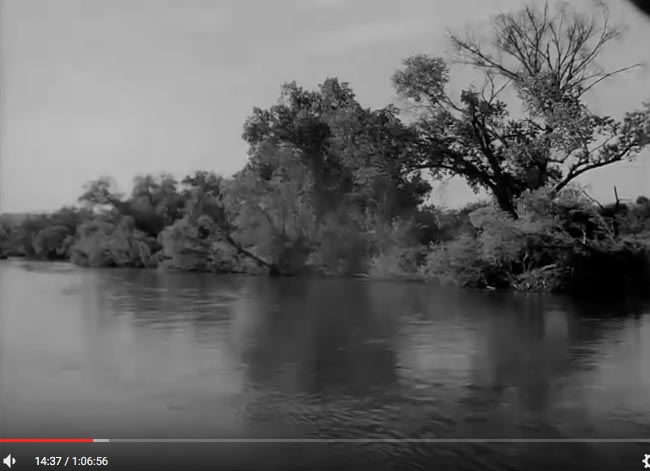
100 LS of Corby walking, shirtless, along the riverbank, carrying a twig. He approaches Sidney and Fletcher who are working on the raft.
CORBY:
You know? There's nothing so refreshing...
101 CU of Sidney, a fly on his face, brushing it away.
CORBY: ...as an afternoon out of doors in enemy territory.
102 Return to shot 100 of Corby standing alongside the riverbank as Fletcher and Sidney work on the raft.
103 MS from low and to the side of Corby stepping up on the raft.
CORBY:
It's really too bad that the sun doesn't burn us green instead of...
104 CU of Fletcher.
CORBY: ...brown.
105 CU of Sidney.
CORBY:
Camouflage! Well, if you see some strange faces...
106 CU of Fletcher.
CORBY: ...across the way, just wave to them casually and try to look as native as possible.
107 Return to shot 104 of Corby standing on the raft, viewed from the waist down, Fletcher and Sidney working on the raft. Corby joins them.
108 LS of the woods and Mac emerging.
MAC:
Lieutenant!
109 MS of Corby looking up, Fletcher and Sidney behind.
110 MS of Mac coming out of the woods.
MAC: Lieutenant! Come here. Bring your binoculars.
111 Corby rises.
112 Corby joins Mac.
CORBY: What do you want?
113 MCU Sidney.
MAC: I'd like you to see something.
Around the river bend.
114 MLS Mac and Corby.
CORBY: What?
MAC: I can't make out exactly what it is, but I think you'll be interested. Come on!
115 MCU from behind as they descend the other side of the hill to the river, around the bend now.
MAC (pointing left down the river):
Over there. See?
116 MCU from front of Corby and Mac as Corby gets out his binoculars.
MAC: Looks like some kind
of small air strip.
117 POV of Corby looking through the binoculars at the air strip.
CORBY:
Yes, you're right.
118 MCU of Corby and Mac, Corby looking through the binoculars.
119 Binoculars POV of military around steps of house. A Captain stands on the stairs (we will later see he is played by Fletcher) and a General approaches (we will later see he is played by Corby).
CORBY: Lots of rank around.
It looks like a General!
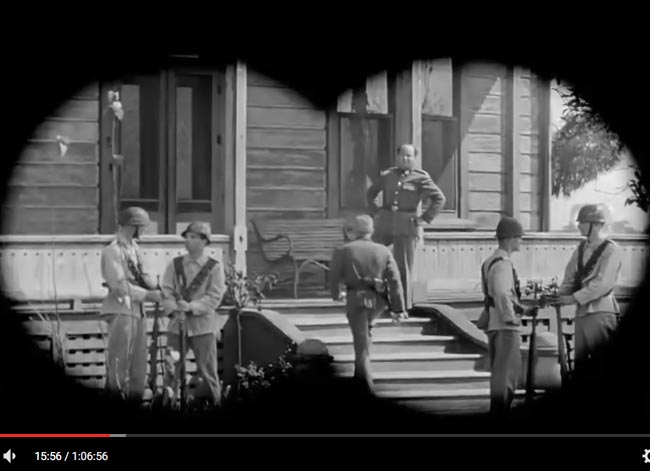
120 Return to shot 118, Corby lowering the binoculars. Mac takes them.
121 CU of Mac looking through the binoculars.
122 POV through binoculars of the airstrip.
MAC: Sure.
123 CU of Mac looking through the binoculars.
124 POV through binoculars of the general on the stairs.
MAC:
Sure. A General! He is a General!
125 MS Corby tries to take the binoculars back from Mac.
CORBY:
Let's get back and help on the raft.
Mac, let's go!
Mac finally hands over the binoculars.
126 MLS of Corby and Mac ascending the hill away from the river and toward the camera. Fade to black.
127 LS of the raft surrounded by the men who are putting back on their shirts.
FLETCHER (laughing):
All we need now is...
128 From the rear of Fletcher as he advances toward the raft.
FLETCHER: ...Huckleberry Finn.
CORBY: This oughtta see us through.
FLETCHER (lying on the raft): Yeah, it doesn't look bad at all.
129 MCU of Fletcher as Mac steps his foot on his chest, Fletcher laughing.
130 Brief CU of Mac laughing.
131 Return to shot 128 of Fletcher lying on the raft with the others standing around.
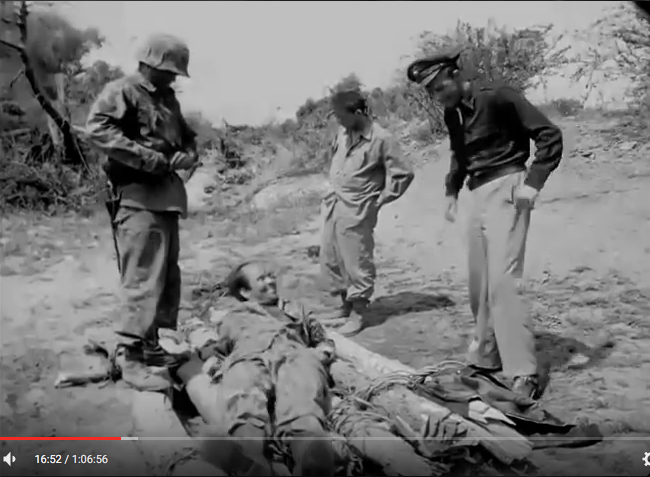
132 CU of Sidney.
SIDNEY:
Should we make sure it floats?
133 Return to shot 131, Corby putting on his jacket.
CORBY:
Rafts always float.
It's unfortunate that we don't have
a distinguished bottle to christen it with.
MAC: Yeah. We could give it...
134 CU of Corby looking up startled.
MAC: ...a name...
135 Extreme and brief close-up of Sidney looking up.
136 Extreme CU of Mac looking up.
137 Return to shot 133 perspective, Corby looking up, Sidney throwing himself down, then all else following suit. We finally hear the plane.
138 The prop plane coming in low and passing over.
139 The men lying on the ground.
140 The sky.
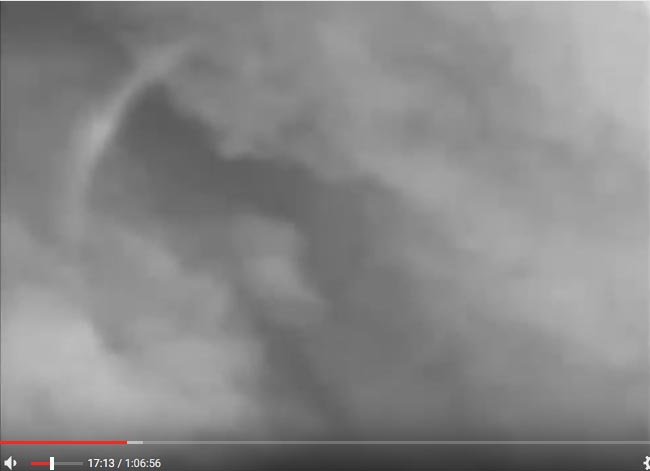
141 The men sit up.
SIDNEY:
He must have seen us! If we stay here, we'll get killed!
142 CU of Mac.
CORBY: It's starting to get...
143 CU of Fletcher.
CORBY: ...dark. I don't know. Perhaps they didn't see us.
144 Sidney already standing, Corby rising.
CORBY:
But it's too dangerous to wait here until we find out.
145 CU of Mac.
SIDNEY:
What are we gonna do?
146 Corby and Mac in the foreground, Sidney and Fletcher to the rear, Sidney on his knees as he buckles up.
SIDNEY:
How are we gonna get back?
CORBY:
Hurry up, let's go!
147 CU of Mac.
MAC:
That plane must have landed down by that house we saw before.
148 MS Mac and Corby.
CORBY:
What's the difference?
149 MS Sidney and Fletcher.
MAC:
There must be something big going on down there.
150 MS Mac and Corby.
CORBY:
Maybe the generals are having a convention tonight.
Corby walks off, dismissive, and Mac follows.
151 From the rear of the men walking away from the river. Fade to black.
BUILDING THE RAFT AND SEEING THE ENEMY : THINGS TO NOTE
We will pass over the question of where the rope for the raft comes from and the feasibility of these men accomplishing so quickly (and with only knives) the logging that would give them the wood for the raft. I'm reasoning this is one of those "It's a movie" things.
Camouflage and Huckleberry Finn
"It's really too bad that the sun doesn't burn us green instead of brown. Camouflage! Well, if you see some strange faces across the way, just wave to them casually and try to look as native as possible," Corby says, which seems an attempt at foreshadowing, for soon they'll be seeing the enemy, but it's a rather youthful approach to dialogue that seriously wants to say things in big purpose ways in a somewhat poetic manner but flops. Fear and Desire is rife with examples that a good actor would have difficulty saying, and Kenneth Harp wasn't the one to carry it off. It's the kind of bad dialogue that is simply going to happen in early efforts, it's almost unavoidable, and you get better as you go along and then you look back on your earlier efforts and want to hide them away and wonder why you hadn't realized at the time it was bad dialogue. Kubrick went pretty light on dialogue in Killer's Kiss, his next film.
As for Huckleberry Finn. In this I believe you can hear Kubrick and Sackler trying to work in Trinculo trying to identify what Caliban is, saying it has fins, and is both fish-like and a man. Caliban is certainly associated with Mac, who is the one who will later ride down the river on the raft, and the film ends with Mac and Sidney on the raft. Indeed, when the girl appears in the film she is out catching fish. Afterwards, as she walks through the woods with her net, upon hearing the men, who does she first spy? Mac. She has caught him. Again he is associated with fish and thus Caliban.
It is many many years since I've read Huckleberry Finn but certainly we could have also an allusion to that book with the raft, for the raft, which carried Huck and Jim, an escaped slave, away from civilization, will be the vehicle for Sidney and Caliban, who are the two outsider soldiers, Caliban aligned with Mac and Ariel/Trinculo aligned with Sidney.
The skewing of the sense of direction
Kubrick's communicating sense of direction in this film has baffled me. I don't know whether it's intentional or not but the later scene in the enemy cabin is staged and edited so my sense of placement of the characters in relationship to their environment is always skewed, and ditto the relationship of the position of the making of the raft to the General's base. Kubrick does make it explicit that Corby and Mac go over a rise to see the enemy camp, but the way things are filmed I always visualize the enemy camp being on the other side of the river, when of course it is on this side of the river as Fletcher and corby reach it by foot. This may be just me.
The maze in The Tempest and deja vu
Later, when the soldiers stumble upon the cabin, Mac wonders at not having seen it before while Corby insists that they have not been in this direction. The forest acts as a kind of maze in this film, and as the soldiers wander it they experience the feeling of having been in the same area before, as it is so much the same, yet it is also different. Gonzalo, in The Tempest, identifies his situation with a maze when he says, "Here's a maze trod indeed, Through forthrights and meanders."
The plane, the circle in the sky, and the mouse-trap
This scene's ultra-Kubrickian film choice is shot 140, the clouded, pale gray sky after the plane is gone, burnished by a mind-bending, glare of a circle, which also briefly appears in shot 138.
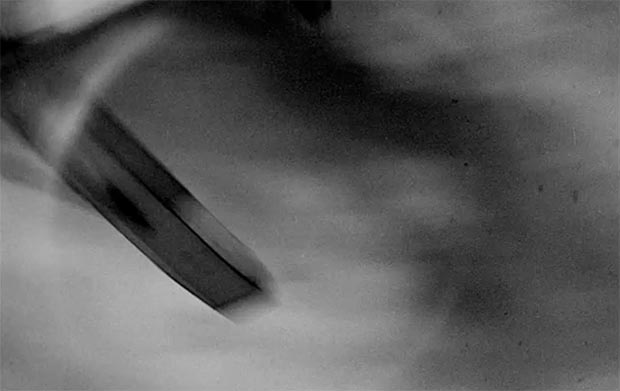
Who but Kubrick? You know someone said, "Why, Kubrick, why?" I wonder what his answer was. The circular artifact appears yet again later in the movie, always in conjunction with scenes concerning the plane. If this artifact is intentional, the answer may be found in the map of the "trap" that Corby drew, he speaking of how it could be used as a mousetrap. The airplane is a cross-form. It is not at the center of the circle now. Later, however, this plane is what will be used for Corby and Fletcher to escape, and as they run toward the plane, we will see the circle again and it will encompass Corby, Fletcher, and the plane. The intent may be that we associate this with Corby's mouse trap drawing.
THE KILLING DINNER
152 Mostly silhouette view from below of the men walking along the top of a hill. They pass right to left.
153 MS of them hiding behind some bushes. Music starts.
154 A house.
MAC:
We didn't see this on the way to the river.
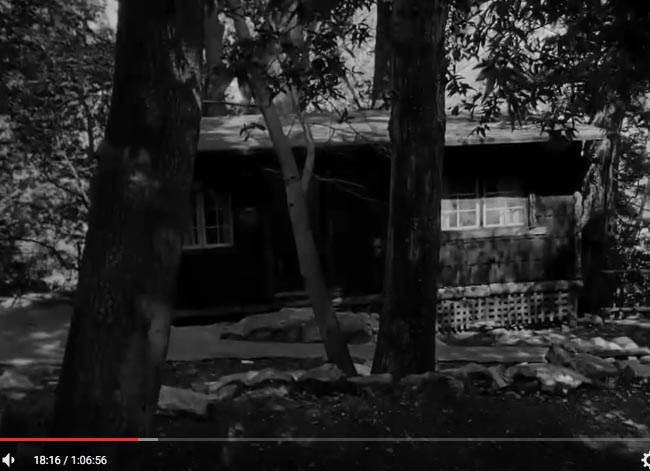
155 Return to shot 153.
CORBY: Well, we've been running in a new direction.
156 Shot through window of two soldiers eating at a table.
SIDNEY: Whatever junk they're eating sure smells good.
CORBY:
Like mother's own. Those guns look even more tempting
than the food does. I've got an idea...
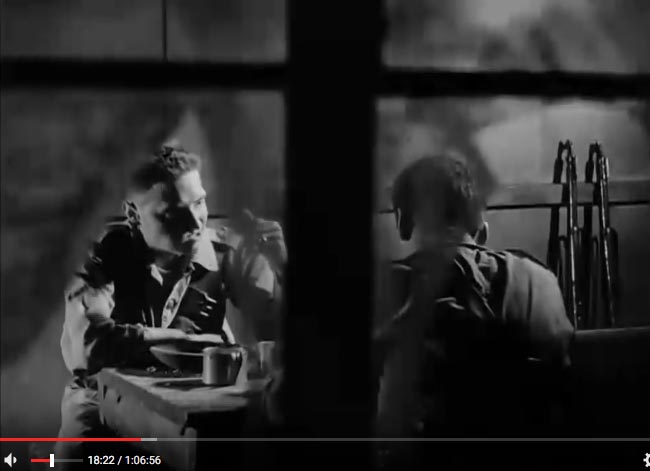
157 Return to shot 155.
CORBY:
Look, no matter what we do from here on,
we're much better off with some guns.
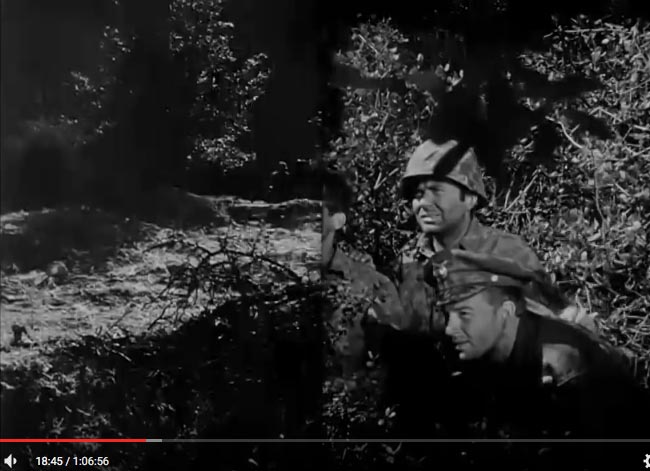
158 Swipe to LS of the men coming up over a rise and crossing left to right before the camera.
159 MS of Fletcher and Mac approaching the door of the house, then Sidney and Corby.
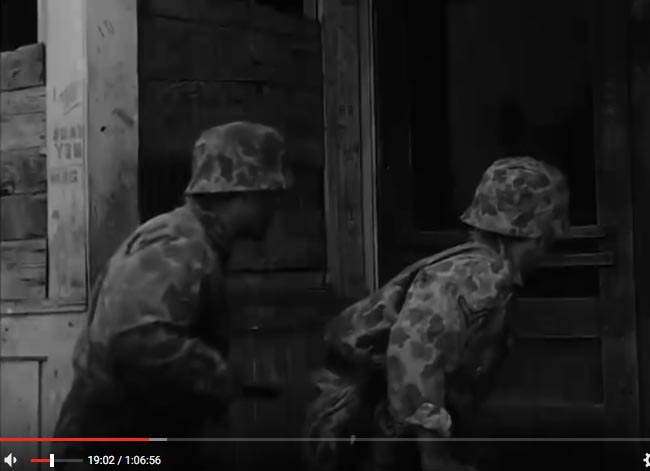
160 MCU of Corby, Sidney and Mac. Corby has his gun drawn.
161 CU of Mac glancing back.
162 CU of Sidney looking down at Corby's gun which is pointed at him.
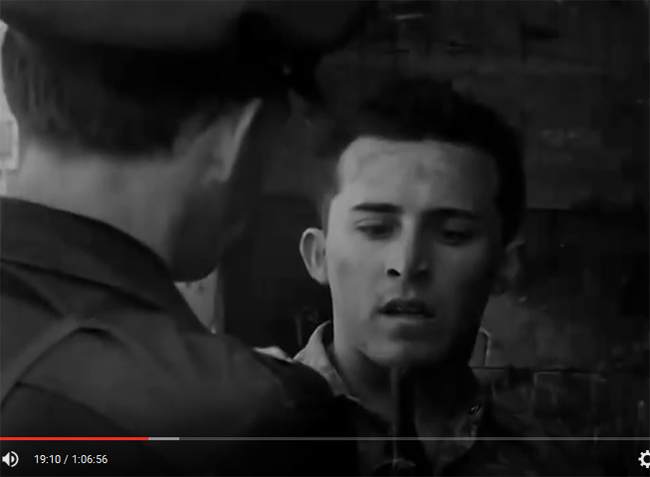
163 CU of Mac.
164 Return to shot 160 and the reluctant Sidney being nudged forward with the gun.
165 CU of Mac glancing back again.
166 From the interior of the cabin, MS of Mac and Fletcher bursting through the door.
167 MCU of the two soldiers turning toward them.
168 Behind one of the soldiers as he is pushed back.
169 CU of Mac stabbing toward the camera with his knife.
170 CU of soldier on the ground.
171 CU of Mac stabbing.
172 CU The soldier gasping.
173 MCU of the other soldier on the ground.
174 A hand slaps a bowl of stew that has fallen on the ground.
175 CU of a knife.
176 CU of Mac stabbing.
177 Return to shot 172 and the soldier gasping.
178 The other soldier on the ground again.
179 The hand closes into a fist crushing potatoes.
180 CU of Mac stabbing toward the camera again.
181 Again as shot 177 with the soldier on the floor gasping.
182 CU of the dinner knife again.
183 CU of Mac stabbing toward the camera again.
184 CU of the dinner knife on the floor again.
Shot 167 | Shot 168 |
 | 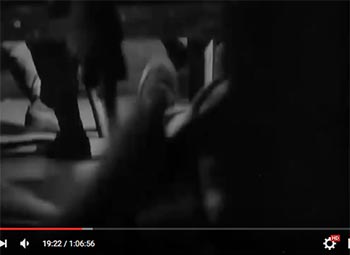 |
Shot 169 | Shot 170 |
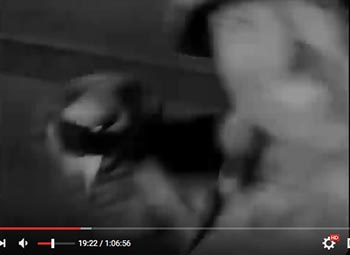 |  |
Shot 171 | Shot 172 |
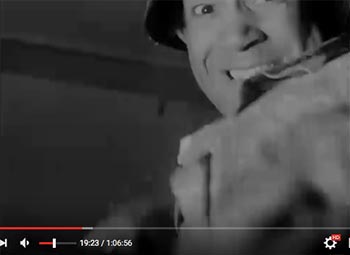 | 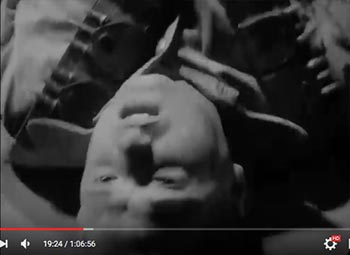 |
Shot 173 | Shot 174 |
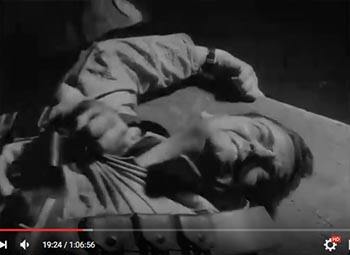 |  |
Shot 175 | Shot 176 |
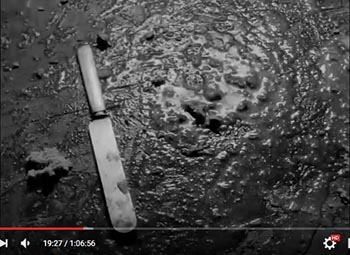 | 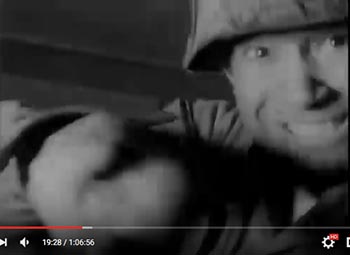 |
Shot 177 | Shot 178 |
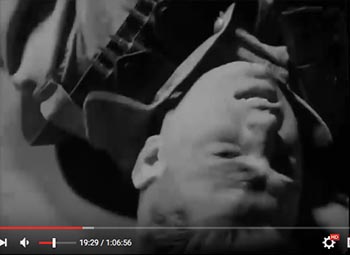 | 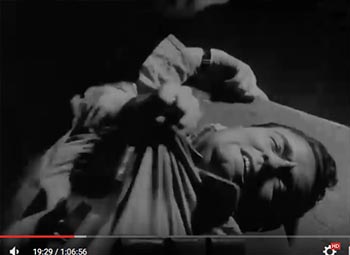 |
Shot 179 | Shot 180 |
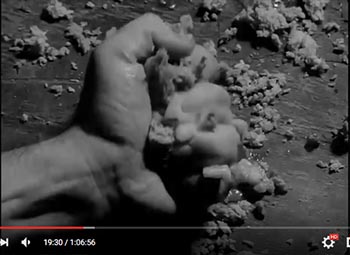 | 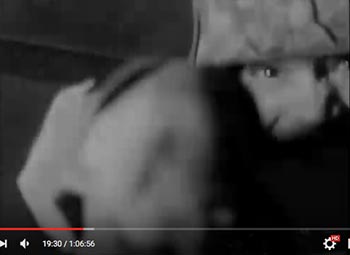 |
Shot 181 | Shot 182 |
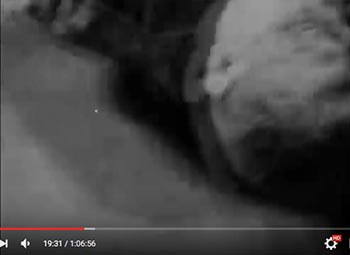 |  |
Shot 183 | Shot 184 |
 | 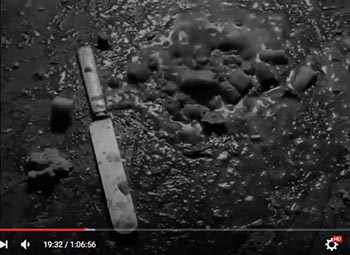 |
185 CU of the hand grasping the potatoes opening wide and relaxing.
186 MS from below of Corby holding his gun.
187 CU of a shocked Sidney.
188 MS of the lower half of the body of one of the soldiers on the floor, feet near a bowl, seat overturned. A hand grabs the soldier's pant legs and pulls him to the far side of the room.
CORBY:
You better hurry. There may be others around.
MAC: I'm gonna get some of that stew first.
189 CU of hand on the floor beside a bowl of stew.
CORBY:
Sidney, better grab something to eat.
190 CU of the dinner knife on the ground.
CORBY:
It may be a long time 'till our...
191 MCU of dead soldier on ground in shadow.
CORBY: ...next feast.
192 CU of face of other soldier, in shadow, right eye open and staring up at the camera.
CORBY: Better eat something.
193 CU from below of Corby staring down.
194 Fletcher in silhouette. Sidney seated across from the camera.
195 CU of the same individual as in shot 193 but from a different perspective.
196 CU of Sidney resting his cheek on his hand on the table.
197 CU of Fletcher.
198 MS of the four men at the table, Mac to the rear eating.
FLETCHER:
How's the stew, Mac?
199 CU of Mac slurping down his stew.
MAC:
Kinda cold, but cold stew's...
200 CU of Sidney as in 196 with his cheek on his hand.
MAC: ...all right.
CORBY:
Cold stew on a blazing island. We've just made a perfect definition of war, Mac.
MAC: That's ducky.
CORBY: Of course. A blazing island...
201 Shot of both men dead men on the floor.
CORBY: ...with a tempest
of gunfire around it.
202 LS of the men at the table, Corby walking around by Mac and to the other side of the table again.
CORBY:
Perhaps if we could...
There's a sound and they stop.
203 CU of the door.
204 CU of Fletcher.
205 CU of Sidney with Corby's drawn gun behind him pointed toward the door.
206 The door. It begins to open.
207 MCU of Mac cocking a rifle.
208 Mac and Corby with the guns pointed at the door.
209 The door opens and a man walks through it with an armload of wood.
210 Brief CU of the man looking up.
211 MS of Mac firing.
212 CU of Corby's gun firing.
213 MS of the man falling back.
214 CU of the wood crashing to the floor.
215 The man falls to the ground.
216 Shot similar to 201 of the first two men lying dead on the floor.
MAC: Somebody must have heard us.
CORBY: Grab those guns and let's get going.
FLETCHER: Well, why did you have to shoot?
MAC: Forget it. Let's move!
The legs of the other men stepping over those dead. Corby steps forward and stops beside the soldiers.
217 CU of Corby staring down.
Music begins. Subtle.
CORBY VOICE-OVER:
We spend our lives running our fingers down the lists...
218 CU of dead soldier, eyes in shadow.
CORBY: ...and directories, looking for...
219 CU of other soldier, eye open and staring toward the camera.
CORBY: ...our real names, our permanent addresses.
220 Both men dead on the ground.
221 CU of man's twisted legs beside the door.
CORBY: No man is an island?
222 CU of Corby.
CORBY: Perhaps that was true a long time ago, before the Ice Age.
The glaciers have melted away and now we're all islands...
223 Dead man staring up at the camera again.
CORBY: ...parts of a world...
224 Dead soldier staring up at camera with eyes in shadow.
CORBY: ...made of islands only.
MAC: Hey!
225 Low shot of the 2 dead soldiers and Corby standing beside them.
MAC:
How long are you gonna hang around here?
226 Corby stepping past the legs of the dead man by the door. He opens the door pushing back his legs in a crumple and closes it.
227 Exterior. The men running away. Fade to black.
THE KILLING DINNER: THINGS TO NOTE
Corby's Control of Sidney and The Tempest
There are so many Kubrickian things going on here that I don't know where to begin, so let's start with the fairly simple, such as shot 162 when Corby has the gun briefly pointed right at Sidney, which reads as a silent threat to keep him from backing out on the raid. Corby then gestures with the gun signaling that Sidney is to go into the cabin, but there is that instant when Sidney looks, shocked, at the gun leveled directly on him. Corby is at this point a strange and dangerous guy. If this were another story, his own men might end up murdering him for the good of the troops. In this story, however, he begins eventually to develop a conscience.
If we are to compare this to The Tempest, a best parallel would be the control that Prospero exerts over Ariel who can be reluctant to carry out Prospero's orders, and bows to Prospero's threat of imprisoning him again in the tree where he originally found him, Ariel having been placed there by Caliban's mother, Sycorax.
On the flipped shots and diagonals
But on to the bizarre shots and editing going on here, with the soldiers who have been killed and the remains of their meal, which make this film very fledgling Kubrick.
Shots 167 through 226 are oddball in context of this film, much of which is shot in a straightforward (even mundane) fashion. That's all there is to it, no getting around it. Completely oddball for the 1950s. Look at all those flips, which he would utilize in later films but more subtly, sometimes to illustrate an idea of doubling/oppositions. Shot 170 flips to 172. 192 flips to 195. Shot 191 flips to 218 and 224. The flipped legs in shot 221. The angles are already out of the ordinary, and we have vignetting that jumps in out of nowhere, such as in shot 221. Can you imagine this in the theaters in 1953? One has to wonder what the audience was thinking?
One can even see from the black edging on shots 195, 218, 219, 223 and 224 that these shots have been flipped and are thus smaller.
We have a number of diagonals cutting through shots as well, such as in shot 192 and the flipped version in 195. These diagonals of the chair leg beside the dead man carry over to the door of the cabin with the stand-out diagonal of the board in shots 203 206, 209 and especially with the crossfade in shot 213 when that diagonal of the board nailed on the door pops out, its lighter color reflecting the light brightly, even glaring, against the darker wood.
We will find these same flips with the woman when she is killed. Where Kubrick really made use of reversals, however, was in 2001, many of them slipping completely by the notice of the audience.
The benign knife and the murderous, the CU of the hand clutching the stew, the eyes of the living and the dead, the expression of the dead as liminal, and the the relationship of the dead in Fear and Desire to the mannequins in Killer's Kiss and Eyes Wide Shut
My guess is the shots of the butter knife on the floor are intended to be a response to the warrior trench knives that slay the first two soldiers. Just as Corby and Fletcher will meet their reflections in the enemy General and the Captain, and find they are cut from the same cloth, the two versions of the knife may represent the same duality. One is non-lethal, used for eating food, while the other is used for killing, and these are placed together in stark contrast.
But that stew. All the shots of that stew are a young Kubrick's mind staring back at you from the silver screen, and everyone in their theater seats are wondering, "What in the world is it with that stew?" Someone probably asked Kubrick, "What's up with the stew?"
The hand gripping the dripping, sloppy stew and then relaxing open in death, filled with potatoes. You know someone said to Kubrick, "Why?"
I'm not putting these images down and saying, "Oh, crazy Kubrick". This is the young artist's mind trying to work out style and purpose and build a bridge between. How can I communicate with film, without words? How can I visually nest my ideas within the blueprint of the plot? That is what a young Kubrick is trying to do in a bold, experimental manner here, which makes this a riveting early sequence to look back on.
As far as just good shots, there are some in this scene that are great and could have been used to fill out some screen time rather than just speeding past them. This section is akin to taking a Lynchian-Coen Brothers film noire sensibility, compressing it down into a solid few minutes of WTF, and the rest of the film being mostly bled dry cinematically, because the majority of the rest of the film doesn't have anything like this style or much of any style at all. But then this scene is indoors, not outdoors, and elsewhere Kubrick is trying to cope with all those leaves and branches and blades of grass. We have here Kubrick art before he learned to make Kubrick art work, as well as buffering it so it would pass as a little more normal for the broader audience. At least that's my take on the couple of sections in the film that are like this one.
Corby and the others sit alongside the dead, not bothering to close the eyes of one of the men, while it's difficult to tell if the eyes of the other man remain open as they're in severe shadow. As we don't see much evidence of blood the men eerily seem to instead sleep with their eyes open, just as happens later with the woman. Obviously, we are to understand they are dead, but this ethereal quality is fitting of a story inspired by The Tempest, in which nothing is quite as it seems. Regardless, the callousness of Corby, and Mac in particular, stands out, in their relaxed proximity to the dead, while the impressionable, shocked Sidney begins to take on aspects of the dead men in the manner in which he stares mutely, blankly upon the scene.
As for Corby's thoughts, well, I believe I'm just going to not comment except to say, once again, young writers can come up with some really lousy stuff. There are ideas that are trying to be vocalized and are getting lost in the chasm between fuzzy inspiration and articulation. Corby's meditations on the island would seem to connect with the later scene in which Sidney recites from The Tempest, but they fail in being an effective set-up for Sidney's madness.
One thing you can sure feel is that stew. That's visceral. The murders? Not so much. The stew? Absolutely. Gotta go wash your hands visceral.
And the legs. One feels the pathetic death of the soldier who carried in the logs with his legs being shoved aside by the door. Kubrick manages to make one feel the waste of life and the fragility of it. The crumpled legs succeed in communicating what the vacant, staring eyes of the other dead men, though striking images, somehow fail to impart in their mannequin likeness, while the legs are chaotic and sell a pathetic, broken body.
The eyes of the dead, though blank, seem to still offer something within, as if a ghostly window on the world.
Kubrick will return to mannequin likenesses in his next feature film, Killer's Kiss, a battle scene occurring in a mannequin warehouse, the mannequins staring on as witnesses. In Eyes Wide Shut, the mannequins at Rainbow Fashions even move about, the sultan/magician mannequin switching places with the mannequin of a woman, in a long dress, holding a parasol, as do other mannequins switch places.
The border between the dead and living is so fresh here as to be porous, uncertain. The dead, as with the mannequins in Killer's Kiss and Eyes Wide Shut, are liminal, communicating the sensation of being potential vessels of spirit. The underworld is not so distant from the "real" world.
The banquet in The Tempest
Corby refers to the dinner as a "feast" and is insistent that Sidney partake, which he doesn't do.
To understand this scene a little better we need to visit the feast in The Tempest on which I imagine it's based, though very different.
Enter PROSPERO above, invisible. Enter several strange Shapes, bringing in a banquet; they dance about it with gentle actions of salutation; and, inviting the King, & c. to eat, they depart
ALONSO
Give us kind keepers, heavens! What were these?
SEBASTIAN
A living drollery. Now I will believe That there are unicorns, that in Arabia There is one tree, the phoenix' throne, one phoenix At this hour reigning there.
ANTONIO
I'll believe both; And what does else want credit, come to me, And I'll be sworn 'tis true: travellers ne'er did lie, Though fools at home condemn 'em.
GONZALO
If in Naples I should report this now, would they believe me? If I should say, I saw such islanders-- For, certes, these are people of the island-- Who, though they are of monstrous shape, yet, note, Their manners are more gentle-kind than of Our human generation you shall find Many, nay, almost any.
PROSPERO
[Aside] Honest lord, Thou hast said well; for some of you there present Are worse than devils.
ALONSO
I cannot too much muse Such shapes, such gesture and such sound, expressing, Although they want the use of tongue, a kind Of excellent dumb discourse.
PROSPERO
[Aside] Praise in departing.
FRANCISCO
They vanish'd strangely.
SEBASTIAN
No matter, since They have left their viands behind; for we have stomachs. Will't please you taste of what is here?
ALONSO
Not I.
GONZALO
Faith, sir, you need not fear. When we were boys, Who would believe that there were mountaineers Dew-lapp'd like bulls, whose throats had hanging at 'em Wallets of flesh? or that there were such men Whose heads stood in their breasts? which now we find Each putter-out of five for one will bring us Good warrant of.
ALONSO
I will stand to and feed, Although my last: no matter, since I feel The best is past. Brother, my lord the duke, Stand to and do as we.
Thunder and lightning. Enter ARIEL, like a harpy; claps his wings upon the table; and, with a quaint device, the banquet vanishes
ARIEL
You are three men of sin, whom Destiny, That hath to instrument this lower world And what is in't, the never-surfeited sea Hath caused to belch up you; and on this island Where man doth not inhabit; you 'mongst men Being most unfit to live. I have made you mad; And even with such-like valour men hang and drown Their proper selves.
ALONSO, SEBASTIAN & c. draw their swords You fools! I and my fellows Are ministers of Fate: the elements, Of whom your swords are temper'd, may as well Wound the loud winds, or with bemock'd-at stabs Kill the still-closing waters, as diminish One dowle that's in my plume: my fellow-ministers Are like invulnerable. If you could hurt, Your swords are now too massy for your strengths And will not be uplifted. But remember-- For that's my business to you--that you three From Milan did supplant good Prospero; Exposed unto the sea, which hath requit it, Him and his innocent child: for which foul deed The powers, delaying, not forgetting, have Incensed the seas and shores, yea, all the creatures, Against your peace. Thee of thy son, Alonso, They have bereft; and do pronounce by me: Lingering perdition, worse than any death Can be at once, shall step by step attend You and your ways; whose wraths to guard you from-- Which here, in this most desolate isle, else falls Upon your heads--is nothing but heart-sorrow And a clear life ensuing.
He vanishes in thunder; then, to soft music enter the Shapes again, and dance, with mocks and mows, and carrying out the table
PROSPERO
Bravely the figure of this harpy hast thou Perform'd, my Ariel; a grace it had, devouring: Of my instruction hast thou nothing bated In what thou hadst to say: so, with good life And observation strange, my meaner ministers Their several kinds have done. My high charms work And these mine enemies are all knit up In their distractions; they now are in my power; And in these fits I leave them, while I visit Young Ferdinand, whom they suppose is drown'd, And his and mine loved darling.
Exit above
GONZALO
I' the name of something holy, sir, why stand you In this strange stare?
ALONSO
O, it is monstrous, monstrous: Methought the billows spoke and told me of it; The winds did sing it to me, and the thunder, That deep and dreadful organ-pipe, pronounced The name of Prosper: it did bass my trespass. Therefore my son i' the ooze is bedded, and I'll seek him deeper than e'er plummet sounded And with him there lie mudded.
Exit
SEBASTIAN
But one fiend at a time, I'll fight their legions o'er.
ANTONIO
I'll be thy second.
Exeunt SEBASTIAN, and ANTONIO
GONZALO
All three of them are desperate: their great guilt, Like poison given to work a great time after, Now 'gins to bite the spirits. I do beseech you That are of suppler joints, follow them swiftly And hinder them from what this ecstasy May now provoke them to.
ADRIAN
Follow, I pray you.
Exeunt
The banquet scene in The Tempest serves to remind Antonio, Alonso and Sebastian of those things for which they should feel guilty, bringing them fresh to mind and making so solid an impression of them that they become inescapable. Indeed, the men are tormented to the point of madness, for which reason Ariel will later plead with Prospero to release them from their torment.
We have no prior histories for the men in Fear and Desire, so this scene gives us not only the banquet of guilt, but the source for guilt that later torments Sidney, who after going over the edge will be aligned with Ariel and the jester, Trinculo.
Instead of the usurpation of Prospero having occurred in the past, for which the harpy Ariel awakes guilt, the company sweeps in upon the feast of the two soldiers, killing them outright for their weapons, upsetting their meal, and will now pay the penalty. Though Corby is viewed somberly masticating in one shot, only Mac, as Caliban, finds the stomach to eat with gusto. The appetites of the rest are gone, guilt beginning its oppression. Aside from Mac, each sit silent in their thoughts as the distinct islands that Corby imagines they are.
We have passed this way before
Though Corby insists they've been running in a new direction, Mac wonders at their not having seen this cabin previously, and Mac is the one that the play several times places our trust in over Corby. Regardless, Kubrick first wound us through the maze of a forest and now, with Mac, raises the suggestion that they have passed this way before. Ideas suggested in this can be found in Nietzsche's "The Eternal Return", which Kubrick expressly refers to in 2001, and in the metaphor of the maze.
Sigils and the illusory death of Ferdinand in The Tempest
Just as we may view the "map" Corby drew of the area as a sigil (shot 27), so can we also view the grafitti--the letters and various shapes--carved into the wood of the cabin, around its door frame, as magical sigils somehow related to the action.
Yes, of course this looks like simple grafitti, but this is The Tempest and is magical territory.
Even if some of the graffiti was inscribed prior the film, was all of it? My attention goes to the word "prince" included in the grafitti, in English, toward the top of frame. An allusion to Prince Ferdinand? RB is also seen and RB is a Hebrew word for, among other things, princes and officers.
Two individuals carried wood for Prospero, Caliban and Prince Ferdinand, and we should remember the man in the moon who carried sticks. In fact, Ferdinand is forced to carry so much wood it's like torture and Miranda must apologize for her father. So it's interesting that we have a man carrying wood who innocently happens in on the dinner, where two of his fellow soldiers have been killed, and is shot to death by both Corby and Mac. That they would do so is a perplexity as the gunshots might have been heard by the enemy, for which reason they flee. As the soldier was carrying wood, there was certainly time to overpower him rather than shoot him. But in the film he seemingly must be shot.
With whom does this individual link? Caliban, who believes he is as a Prince of the island and its rightful heir? Prince Ferdinand? It is in the feast scene that the harpy Ariel announces to Alonso that he has been "bereft" of his son as payment for his past deeds. For much of the play, Alonso believes Ferdinand to be dead. And yet Ferdinand lives, he is not dead. Nothing is as it seems in The Tempest. Reversals pile upon reversals.
We spend our lives running our fingers down the lists and directories, looking for our real names...
It's worth noting that in the appended intro of Kubrick's first short film, The Day of the Fight, there is a scene in which Walter Cartier's name is looked up in a director of boxers. Walter's original family name was McCarthy. Walter's grandfather changed the name to Carter then Cartier, and Walter originally fought under the name Wally "Twin" Carter.
The rebuke of "no man is an island", and Corby's assertion that war is as a cold stew on a blazing island with a tempest of gunfire around it
The script refers to John Donne's Devotions upon Emergent Occasions written in 1623 while he was ill.
No man is an Iland, intire of it selfe; every man is a peece of the Continent, a part of the maine; if a Clod bee washed away by the Sea, Europe is the lesse, as well as if a Promontorie were, as well as if a Mannor of thy friends or of thine owne were; any mans death diminishes me, because I am involved in Mankinde; And therefore never send to know for whom the bell tolls; It tolls for thee
Corby rebukes the sentiment that "no man is an island", proposing instead that every individual is solitary, each composed of their own island, describing the island of The Tempest.
June 2014 but transferred in March 2016 to this form. Approx 14,830 words or 30 single-spaced pages. A 114 minute read at 130 wpm.
Go to Part 2
Go to "Fear and Desire" TOC
Go to the TOC for all film analyses

